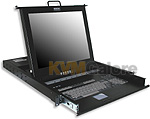Lookup
A glossary of technical terms
Short for 10 Megabit, baseband, 200 Meters. Refers to an older Ethernet standard that used RG-58 Thinnet coaxial to network computers in a daisy-chain topology. This system is antiquated.
Back to TopShort for 10 Megabit, baseband, Twisted pair. An upgrade to Ethernet from 10-Base2, it switched from the coaxial daisy-chain method to using a star topology running over twisted pair cable. This allowed for greater flexibility and reliability. Still used today, although the speeds have increased.
Back to TopShort for 100 Megabit, baseband, Twisted pair. See 10-BaseT. An upgrade that increased the speed from 10 Megabits per second (Mbps) to 100 Mbps.
Back to Top1080i (pronounced "ten eighty eye") is shorthand name for a category of video modes. The number 1080 stands for 1,080 lines of vertical resolution, while the letter i stands for interlaced (or non-progressive) scan. 1080i is considered to be an HDTV video mode. The term usually assumes a widescreen aspect ratio of 16:9, implying a horizontal resolution of 1920 pixels and a frame resolution of 1920×1080 or exactly 2,073,600 pixels.
Back to Top1080p (pronounced "ten eighty pee") is the shorthand name for a category of display resolutions. The number 1080 represents 1,080 lines of vertical resolution, while the letter p stands for progressive scan (meaning the image is not interlaced). 1080p is considered an HDTV video mode. The term usually assumes a widescreen aspect ratio of 16:9, implying a horizontal resolution of 1920 pixels. This creates a frame resolution of 1920×1080, or exactly 2,073,600 pixels. The frame rate in hertz can be either implied by the context or specified after the letter p (such as 1080p30, meaning 30 frames per second).
1080p is sometimes referred to in marketing materials as "Full High-Definition" or "Full HD". Although 2K/4K digital cinema technology is commercially available, 1080p and 1080i are still the highest-resolution formats widely used for broadcasting and consumer distribution of video content.
Back to Top
 [also known as DB13W3] 13W3 is a particular style of D-subminiature connector commonly used as an analog video interface connector that was used primarily on Sun Microsystems, Silicon Graphics and IBM RISC workstations, as well as some displays from Apple Computer, NeXT Computer and Intergraph Corporation. The DB13W3 connector is also used by some 3Com SuperStack Ethernet switches to carry DC power.
[also known as DB13W3] 13W3 is a particular style of D-subminiature connector commonly used as an analog video interface connector that was used primarily on Sun Microsystems, Silicon Graphics and IBM RISC workstations, as well as some displays from Apple Computer, NeXT Computer and Intergraph Corporation. The DB13W3 connector is also used by some 3Com SuperStack Ethernet switches to carry DC power.
The 13W3 connector is no longer used with modern displays, which have generally moved on to VGA or DVI connectors.
Back to Top1440p is the shortened name for a 2,560x1,440 resolution at a 16:9 aspect ratio. It is sometimes referred to as Quad HD because it offers four times the resolution of a 1,280 x 720 HD display. WQHD is another descriptor for the 1440p resolution.
As the TV industry considered its next jump up in resolution beyond 1080p, 1440p was one possibility. Ultimately, though, 1440p was bypassed in favor of Ultra HD or 4K, which offers at least a 3,840x2,160 resolution, or four times that of 1080p.
Even though 1440p will not be a major player in the world of HDTVs and home theater projectors, it still has a place in the consumer electronics industry right now - namely, in laptops, computer monitors and smartphones. A growing number of computer monitors are sporting a 1440p resolution and becoming a popular choice amongst gamers.
In the world of smartphones, the increase in resolution to 1440p offers a huge step up in pixel density at the smaller screen sizes. In 2014, a number of manufacturers have introduced smartphones with a 1440p resolution, including LG, Samsung, Vivo, and Oppo (which is known in America primarily for its disc players but is a major player in smartphones elsewhere in the world).
Back to Top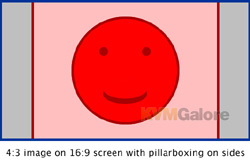 Widescreen aspect ratio used for a video display. The display measured is 16 units wide for every 9 units tall. This creates a rectangular viewing area that better represents a movie theater screen.
Widescreen aspect ratio used for a video display. The display measured is 16 units wide for every 9 units tall. This creates a rectangular viewing area that better represents a movie theater screen.
16:9 has become the standard aspect ratio for HDTV.
Also see: 4:3
Back to Top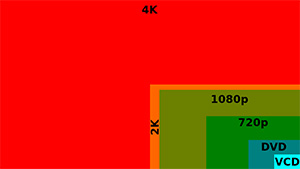
2K is a high-definition video resolution standard that allows slightly higher resolution than 1080p signals - up to 2048x1080.
2K refers to horizontal resolution, in contrast to standard digital TV resolutions which are stated in vertical lines. If 1080p has 1080 lines of vertical resolution (1920x1080), 2K has the same number of lines of vertical resolution with slightly more pixels of horizontal resolution (typically 2048x1080).
2K is mostly used to rate digital cinema formats, since the Digital Cinema Initiative (DCI) backed by the major Hollywood studios uses a 17:9 aspect ratio that better aligns with several of 35mm and 70mm films formats used to shoot and project movies.
Back to Top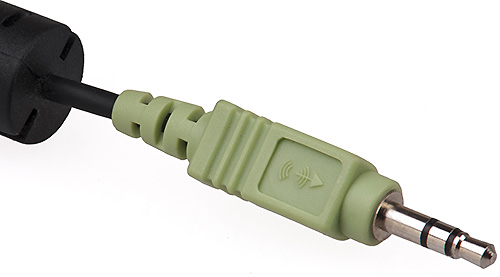 3.5 mm connectors (jacks and sockets) are the most commonly used audio connectors for headphones or audio output signals on MP3 players, smartphones and computers.
3.5 mm connectors (jacks and sockets) are the most commonly used audio connectors for headphones or audio output signals on MP3 players, smartphones and computers.
3.5 mm audio connectors are also termed stereo plug, mini-stereo, mini jack, headphone jack and microphone jack.
The connector is cylindrical in shape, typically with two, three or four contacts. Three-contact versions are known as TRS connectors, where T stands for "tip", R stands for "ring" and S stands for "sleeve". Similarly, two- and four-contact versions are called TS and TRRS connectors respectively.
This type connector was invented for use in telephone switchboards in the 19th century, AKA phone connector. In its original configuration, the outside diameter of the "sleeve" conductor was ¼ inch. The 3.5 mm (approx. ⅛ inch) version is also known as the miniature (or mini) version of a phone connector.
The most immediately recognizable 3.5 mm (⅛") connector is the version often seen as the plug on the end of a pair of headphones.
The 3.5 mm (miniature) size was originally designed as a two-conductor connector for earpieces on transistor radios. The 3.5 mm connector, which is the most commonly used in portable application today, has been around at least since the Sony EFM-117J radio which was released in 1964. It became very popular with its application on the Walkman in 1979.
 Three- four- and five-conductor versions of the 3.5 mm plug are used for certain applications.
Three- four- and five-conductor versions of the 3.5 mm plug are used for certain applications.
A three-conductor version is often used in MP3 music players, iPods and smartphones, providing stereo sound.
A four-conductor version is often used in compact camcorders and portable media players, and sometimes also in laptop computers and smartphones, providing stereo sound plus a video signal.
Proprietary interfaces using both four- and five-conductor versions also exist, where the extra conductors are used to supply power for accessories. The four-conductor 3.5 mm plug is also used as a speaker-microphone connector on handheld amateur radio transceivers and on mobile phones.
The most common arrangement remains to have the male plug on the cable and the female socket mounted in a piece of equipment: the original intention of the design.
A considerable variety of line plugs and panel sockets is available, including plugs suiting various cable sizes, right-angle plugs, and both plugs and sockets in a variety of price ranges.
Back to Top 3D television (3D TV, or 3D) is television that conveys depth perception to the viewer by employing variety of technologies used to create realistic three-dimensional or stereoscopic images on a display.
3D television (3D TV, or 3D) is television that conveys depth perception to the viewer by employing variety of technologies used to create realistic three-dimensional or stereoscopic images on a display.
3D displays can be either...
• Active - requiring viewers to wear special glasses that are electronically synchronized to the display;
• Passive - requiring viewers to wear special glasses that use polarizing technology and do not require electronics, or
• Glasses-free (auto-stereoscopic) displays that do not require glasses.
HDMI uses several different methods to encode the 3D images into the video signals:
• Top-and-bottom
• Side-by-side, and
• Frame-packing
3D signals generally require higher bandwidth than 2D signals.
Back to TopThe 3G, or 3 Gbps variation of SDI (Serial Digital Interface) - an uncompressed digital standard that is transmitted over a 75 Ohm coax cable, using a type BNC connector. The 3G variation allows for 3 Gbps bandwidth needed for a 1080p signal. Used primarily for broadcast applications, as it does not support HDCP.
Back to Top4:2:0 is an expression of chroma subsampling, a practice of encoding images by compressing their color information in order to reduce the overall storage size and bitrate of video files.
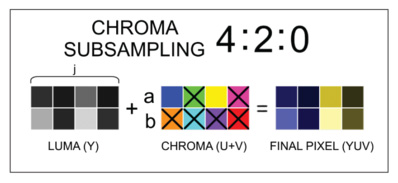 This reduced chroma subsampling takes two chroma samples from the top 'a' row of pixels and none from the bottom 'b' row. Instead, the bottom row shares choma information from the top row sampling. This reduces the overall chroma information to approximately 25 percent of the uncompressed chroma.
This reduced chroma subsampling takes two chroma samples from the top 'a' row of pixels and none from the bottom 'b' row. Instead, the bottom row shares choma information from the top row sampling. This reduces the overall chroma information to approximately 25 percent of the uncompressed chroma.
The configuration of 4:2:0 subsampling is common in HDV and AVCHD (file-based formats for the digital recording and playback of high-definition video), DVD-video, Blu-ray, and in many encoded video formats used by DSLR cameras.
Back to Top4:2:2 is an expression of chroma subsampling, a practice of encoding images by compressing their color information in order to reduce the overall storage size and bitrate of video files.
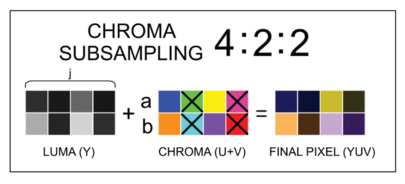 The 4:2:2 chroma subsampling takes two pixels from both the top 'a' and bottom 'b' rows. This reduces the chroma information to 50 percent of the uncompressed source chroma. The two chroma components are sampled at half the sample rate of luma, i.e. the horizontal chroma resolution is halved. This reduces the bandwidth of an uncompressed video signal by one-third with little to no visual difference.
The 4:2:2 chroma subsampling takes two pixels from both the top 'a' and bottom 'b' rows. This reduces the chroma information to 50 percent of the uncompressed source chroma. The two chroma components are sampled at half the sample rate of luma, i.e. the horizontal chroma resolution is halved. This reduces the bandwidth of an uncompressed video signal by one-third with little to no visual difference.
Many high-end digital video formats and interfaces use this scheme - 4:2:2 is one of the more popular chroma subsampling used in producing high-quality video.
Back to Top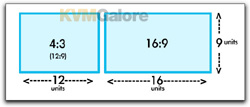 Standard aspect ratio used for a video display. The display measured is 4 units wide for every 3 units tall. This creates an almost square viewing area. Standard TVs (as opposed to HDTVs) and older computer monitors use a 4:3 aspect ratio.
Standard aspect ratio used for a video display. The display measured is 4 units wide for every 3 units tall. This creates an almost square viewing area. Standard TVs (as opposed to HDTVs) and older computer monitors use a 4:3 aspect ratio.
Also see: 16:9
Back to Top4:4:4 is an expression of chroma subsampling, a practice of encoding images by compressing their color information in order to reduce the overall storage size and bitrate of video files.
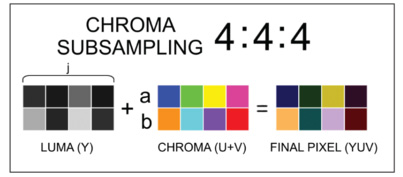 If every pixel in the 4x2 grid gets a chroma sample, there's actually no subsampling taking place, a situation represented by 4:4:4 expression.
If every pixel in the 4x2 grid gets a chroma sample, there's actually no subsampling taking place, a situation represented by 4:4:4 expression.
4:4:4 represents the highest video quality, which effectively has no chroma subsampling. Each pixel is represented and retains its own luma and chroma values.
The best video cameras will have the capability to output 4:4:4 chroma. The same applies to video switches and extenders. These are professional grade tools and they're priced accordingly.
Back to Top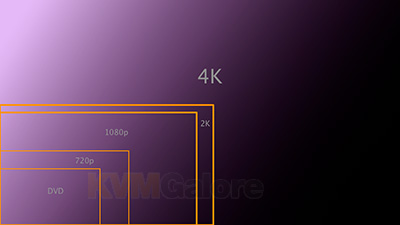 4K is a high-definition video resolution standard allowing about four times the resolution of 1080p signals - up to 4096 x 2160 at 24Hz. Formerly only used for digital projection in theaters, it is becoming a new standard for home theater displays as well.
4K is a high-definition video resolution standard allowing about four times the resolution of 1080p signals - up to 4096 x 2160 at 24Hz. Formerly only used for digital projection in theaters, it is becoming a new standard for home theater displays as well.
4K refers to approximately 4,000 pixels of horizontal resolution, in contrast to standard digital TV resolutions which are stated in vertical lines. If 1080p has 1080 lines of vertical resolution (1920x1080), 4K video has 2160 - double the lines of vertical resolution.
For consumer displays, 4K (also known as Ultra HD [UHD]) video has double the lines of vertical resolution and double the number of pixels of horizontal resolution (3840x2160), maintaining the 16:9 aspect ratio of home-entertainment TVs.
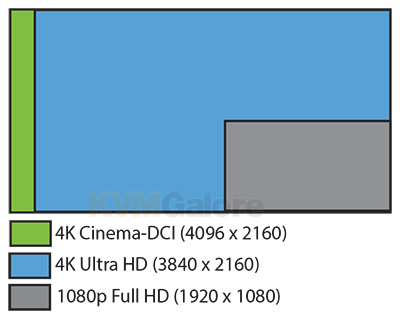 For shooting major motion pictures as well as for cinema theater projection, the film industry likes to shoot at resolutions at least 3-4 times greater than what it will project, so the Digital Cinema Initiative (DCI) backed by the major Hollywood studios came out with a 4K specification (at the same time it came out with the 2K display specification). DCI's 4K has 2160 vertical lines of resolution, which is double that of 1080p, and 4096 pixels of horizontal resolution (4096x2160), which is exactly double that of 2K, thus maintaining the 17:9 aspect ratio that better aligns with several of 35mm and 70mm films formats used to shoot and project movies.
For shooting major motion pictures as well as for cinema theater projection, the film industry likes to shoot at resolutions at least 3-4 times greater than what it will project, so the Digital Cinema Initiative (DCI) backed by the major Hollywood studios came out with a 4K specification (at the same time it came out with the 2K display specification). DCI's 4K has 2160 vertical lines of resolution, which is double that of 1080p, and 4096 pixels of horizontal resolution (4096x2160), which is exactly double that of 2K, thus maintaining the 17:9 aspect ratio that better aligns with several of 35mm and 70mm films formats used to shoot and project movies.
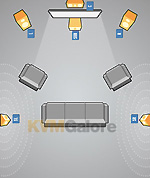 A type of surround sound with 5 distinct sound channels and a LFE (low-frequency effects) channel: Center, Front Left, Front Right, Rear Left, and Rear Right. The .1 refers to the LFE channel, which is so named because it only reproduces the lower 1/10 of the sound frequency (the deep bass tones) of the other channels. Each channel requires a separate speaker. Dolby and DTS both offer 5.1 Surround technologies.
A type of surround sound with 5 distinct sound channels and a LFE (low-frequency effects) channel: Center, Front Left, Front Right, Rear Left, and Rear Right. The .1 refers to the LFE channel, which is so named because it only reproduces the lower 1/10 of the sound frequency (the deep bass tones) of the other channels. Each channel requires a separate speaker. Dolby and DTS both offer 5.1 Surround technologies.
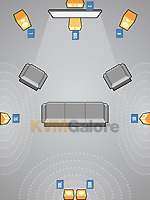 The same as 5.1, with the addition of a Left Rear Center channel, and a Right Rear Center Channel. In a 7.1 setup, the Rear Left and Rear Right of the 5.1 setup are pushed a bit forward to create a more rounded shape to the sound field.
The same as 5.1, with the addition of a Left Rear Center channel, and a Right Rear Center Channel. In a 7.1 setup, the Rear Left and Rear Right of the 5.1 setup are pushed a bit forward to create a more rounded shape to the sound field.
Stands for Audio/Video. Refers to a system that generates both sound (audio) and picture (video).
Back to TopSomething that adapts; an adapter is used to change one connector type to another. Typically an adapter refers to a passive adaptation; i.e. a simple physical change in the connection. The signal is not affected. If the signal is changed, it is more appropriate to use the term "Converter".
Back to Top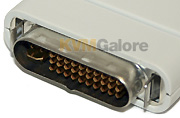
 Short for Apple Display Connector, ADC is a proprietary modification of the DVI connector that combines analog and digital video signals, USB, and power all in one cable.
Short for Apple Display Connector, ADC is a proprietary modification of the DVI connector that combines analog and digital video signals, USB, and power all in one cable.
Apple used ADC for its LCD-based Apple Cinema Displays and their final CRT displays, before deciding to use standard DVI connectors on later models.
Back to TopA type of signal transmission with an infinite number of values within a specific wavelength. Transmitting and storing analog information requires a great deal of bandwidth and resources. Also, because the values are not discreet, analog signals are more susceptible to interference. However, they are less so to signal loss and often the signal of choice for long distance applications.
Back to TopThe original video recording method that stores continuous waves of red, green and blue intensities.
In analog video, the number of rows is fixed. There are no real columns, and the maximum detail is determined by the frequency response of the analog system.
Analog video contains the luminance (brightness) and chrominance (color) of the image, which may be carried in separate channels, as in VGA, component video (YPbPr) and S-video, or combined in one channel, as in composite video and RF connector. Digital video signal formats with higher quality have been adopted and gradually replacing analog video, including serial digital interface (SDI), DVI and HDMI.
Back to TopAudio Return Channel (ARC) is an HDMI 1.4 feature that allows audio from a TV display device to be transmitted over an HDMI cable back to the AV receiver.
ARC transfers audio from the TV back to a home theater receiver via an HDMI cable you already have connected between the TV and the home theater receiver, allowing you to listen to your TV's audio through your home theater audio system instead of the TV's speakers without having to connect a second cable between the TV and home theater system.
For example, if you receive your TV signals over-the-air via antenna, the audio from those signals goes directly to your TV. Ordinarily to get the audio from those signals to your home theater receiver, you would have to connect an extra cable (either analog stereo, digital optical, or digital coaxial) from the TV to the home theater receiver for this purpose. However, with Audio Return Channel, you can simply take advantage of the HDMI cable you already have connected between the TV and the home theater receiver to transfer audio in both directions.
Back to Top A relationship in a display between the width and height. See 16:9, 4:3.
A relationship in a display between the width and height. See 16:9, 4:3.
Aspect ratio is an important consideration when choosing a home theater display.

Advanced Technology Attachment. ATA is a parallel storage interface technology for disk drives and removable media like CD-ROM drives. It was the first technology to integrate the controller onto the drive itself, called IDE or Integrated Device Electronics. Because of this, ATA is also called IDE. However, because many other drive technologies also utilize IDE it is more proper to use the term ATA.
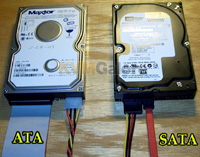 ATA supports two drives per channel, one designated as master and one designated as slave. ATA uses a 40-pin ribbon cable which can be bulky and cumbersome to work with, and is one of the things that lead to the development of SATA. After SATA was released, ATA is now more commonly referred to as PATA for Parallel ATA. ATA has evolved over the years to remain viable by increasing the speed of the bus. Typically ATA will be listed with the speed it supports, such as ATA/66, ATA/100, or ATA/133 for 66, 100, and 133 MB/s respectively.
ATA supports two drives per channel, one designated as master and one designated as slave. ATA uses a 40-pin ribbon cable which can be bulky and cumbersome to work with, and is one of the things that lead to the development of SATA. After SATA was released, ATA is now more commonly referred to as PATA for Parallel ATA. ATA has evolved over the years to remain viable by increasing the speed of the bus. Typically ATA will be listed with the speed it supports, such as ATA/66, ATA/100, or ATA/133 for 66, 100, and 133 MB/s respectively.
Back to Top
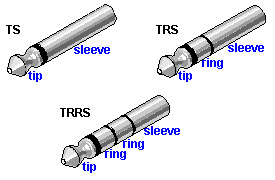 In electronics, audio connector, also known as a phone connector, phone jack, audio jack or jack plug, is a common family of connectors typically used for analog signals, primarily audio.
In electronics, audio connector, also known as a phone connector, phone jack, audio jack or jack plug, is a common family of connectors typically used for analog signals, primarily audio.
The connector is cylindrical in shape, typically with two, three or four contacts. Three-contact versions are known as TRS connectors, where T stands for "tip", R stands for "ring" and S stands for "sleeve". Similarly, two- and four-contact versions are called TS and TRRS connectors respectively.
This type connector was invented for use in telephone switchboards in the 19th century and is still widely used. Specific models are termed stereo plug, mini-stereo, mini jack, headphone jack and microphone jack, or are referred to by size, i.e. 3.5 mm or 6.35 mm.
In its original configuration, the outside diameter of the "sleeve" conductor is ¼ inch (exactly 6.35 mm). The mini connector has a diameter of 3.5 mm (approx. ⅛ inch) and the sub-mini connector has a diameter of 2.5 mm (approx. 3⁄32 inch).
The most immediately recognizable connector is the 3.5 mm (⅛") version of this connector often seen as the plug on the end of a pair of headphones.

3.5 mm tip-ring-sleeve (TRS) is very common as the connector for headphones or audio output signals on MP3 players or computers. Some cell phones provide a 2.5 mm tip-ring-ring-sleeve (TRRS) jack for connecting to headphones that also include a microphone for hands-free communications.
¼" size connectors find a lot of use in the professional audio and music community - most electric guitars and amplifiers have ¼" tip-sleeve (TS) jacks on them.
The 3.5 mm (miniature) and 2.5 mm (sub-miniature) sizes were originally designed as two-conductor connectors for earpieces on transistor radios. The 3.5 mm connector, which is the most commonly used in portable application today, has been around at least since the Sony EFM-117J radio which was released in 1964. It became very popular with its application on the Walkman in 1979.
Three- four- and five-conductor versions of the 3.5 mm plug are used for certain applications.
A three-conductor version is often used in MP3 music players, ipods and smartphones, providing stereo sound.
A four-conductor version is often used in compact camcorders and portable media players, and sometimes also in laptop computers and smartphones, providing stereo sound plus a video signal.
Proprietary interfaces using both four- and five-conductor versions also exist, where the extra conductors are used to supply power for accessories. The four-conductor 3.5 mm plug is also used as a speaker-microphone connector on handheld amateur radio transceivers and on mobile phones.
The most common arrangement remains to have the male plug on the cable and the female socket mounted in a piece of equipment: the original intention of the design.
A considerable variety of line plugs and panel sockets is available, including plugs suiting various cable sizes, right-angle plugs, and both plugs and sockets in a variety of price ranges and with current capacities up to 15 amperes for certain heavy duty ¼ inch versions intended for loudspeaker connections.
Back to TopStands for American Wire Gauge. A measurement of the size or thickness of a wire. The larger the number, the thinner the wire. This standard was developed from a series of measuring gauges made in the 1850s by a Rhode Island manufacturer named Brown & Sharpe.
Back to Top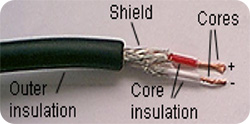 Balanced audio is a method of interconnecting audio equipment using impedance balanced lines. This type of connection is very important in sound recording and production because it allows for the use of long cables while reducing susceptibility to external noise.
Balanced audio is a method of interconnecting audio equipment using impedance balanced lines. This type of connection is very important in sound recording and production because it allows for the use of long cables while reducing susceptibility to external noise.
Balanced audio uses a cable made up of two conductors for the audio signal that are twisted together and surrounded by an overall shield.
The twists in the audio cable help to defer electromagnetic signals. The audio signals on the two signal wires are equal, but of opposite polarity; one wire carries the positive (hot) audio signal, while the other wire carries the inverted negative (cold) audio signal.
The third wire is usually a braided shield that wraps the two signal wires and is typically connected to a grounding port. The shield of the cable is the first line of defense, so to speak. Any interference should be picked by the shield and then deposited to the electrical ground of the system, hopefully never becoming part of the audio signal. The shield of the cable is never part of the audio signal path and should be grounded directly to the frame of the audio equipment.
 The common connector used for balanced audio is the 3-pin XLR connector. XLR connectors are also usually used with microphones because of their durable construction.
The common connector used for balanced audio is the 3-pin XLR connector. XLR connectors are also usually used with microphones because of their durable construction.
When cost and space is an issue, manufacturers have offered alternative 3 way conductor connections called TRS (tip-ring-sleeve) in various sizes, ¼" TRS phone connector being the most popular for professional audio applications. TRS jack plugs are usually used for mixer inputs and outputs because of their smaller profile.
In comparison to unbalanced audio, balanced audio essentially means better, stronger and cleaner signal between devices.
Back to Top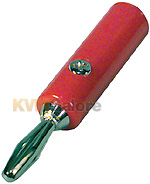 A single pin connector that bulges in the middle (like a banana), used for joining wires to equipment, primarily for speaker connections. A (male) Banana Plug connects to a (female) Banana Jack.
A single pin connector that bulges in the middle (like a banana), used for joining wires to equipment, primarily for speaker connections. A (male) Banana Plug connects to a (female) Banana Jack.
A measure of the amount of data that can be transmitted in a fixed amount of time. Digital signals are measured in bits per second (bps), whereas analog signals are measured in cycles per second, or Hertz (Hz).
Back to TopThe number of symbol changes (signaling events) made to the transmission medium per second using a digitally modulated signal. Used to refer to the number of bits per second when only one bit is sent per clock cycle. 300 baud = 300 bits per second (bps). Today, most transmission systems are capable of sending more than one bit per clock cycle, so the term bps (bits per second) is used instead.
Back to TopRefers to a parallel printer interface that sends data in two directions; both from the computer to the printer, and from the printer to the computer. Bi-directional signals are used to increase transmission speed, and to allow the printer to report status information such as ink levels or error messages.
Back to TopIn computing, BIOS (basic input/output system) is the firmware program a computer's microprocessor uses to start the computer system after it is powered on, to perform hardware initialization during the booting process (power-on startup).
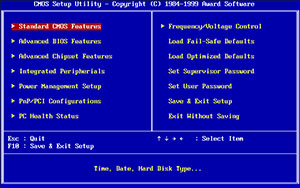 The BIOS firmware comes pre-installed on an IBM PC or IBM PC compatible's system board.
The BIOS firmware comes pre-installed on an IBM PC or IBM PC compatible's system board.
Once the operating system on the computer is up and running, BIOS also manages data flow between the computer's operating system (OS) and attached devices, such as the hard disk, video adapter, keyboard, mouse and printer.
The term BIOS was first coined in 1975 by American computer scientist Gary Kildall. It was incorporated into IBM's first personal computer in 1981 and, in the years to come, gained popularity within other PCs, becoming an integral part of computers for some time. However, BIOS' popularity has waned in favor of a newer technology: Unified Extensible Firmware Interface (UEFI). Intel announced a plan in 2017 to retire support for legacy BIOS systems by 2020, replacing them with UEFI.
The main use of BIOS is to act as a middleman between OSes and the hardware they run on. BIOS is theoretically always the intermediary between the microprocessor and I/O device control information and data flow. Although, in some cases, BIOS can arrange for data to flow directly to memory from devices, such as video cards, that require faster data flow to be effective.
BIOS comes included with computers, as firmware on a chip on the motherboard. In contrast, an OS like Windows or iOS can either be pre-installed by the manufacturer or vendor or installed by the user. BIOS is a program that is made accessible to the microprocessor on an erasable programmable read-only memory (EPROM) chip. When users turn on their computer, the microprocessor passes control to the BIOS program, which is always located at the same place on EPROM.
When BIOS boots up a computer, it first determines whether all of the necessary attachments are in place and operational. Any piece of hardware containing files the computer needs to start is called a boot device. After testing and ensuring boot devices are functioning, BIOS loads the OS -- or key parts of it -- into the computer's random access memory (RAM) from a hard disk or diskette drive (the boot device).
Back to TopBinary Digit – The smallest unit of digital information. A bit represents a single value, usually a 1 or a 0. Bits are usually arranged into more meaningful values by combining them into larger units. See Byte.
Back to Top Blu-ray disc is an optical disc format designed to supersede the DVD format that provides much higher video and audio resolution and capacity than DVD.
Blu-ray disc is an optical disc format designed to supersede the DVD format that provides much higher video and audio resolution and capacity than DVD.
The format was developed by the Blu-ray Disc Association, a group representing makers of consumer electronics, computer hardware, and motion pictures.
The name Blu-ray Disc refers to the blue laser used to read the disc, which allows information to be stored at a greater density than is possible with the longer-wavelength red laser used for DVDs.
The Blu-ray plastic disc is 120mm in diameter and 1.2mm thick, the same size as DVDs and CDs. Although similar in appearance, Blu-ray discs can only be played back on Blu-ray players (although most Blue-ray players can play back DVDs and CDs).
Blu-ray players offer higher-resolution video and un-compressed multi-channel audio over HDMI, but do not support high-definition analog video output.
During the high definition optical disc format war, Blu-ray Disc competed with the HD DVD format. Toshiba, the main company that supported HD DVD, conceded in February 2008, releasing its own Blu-ray Disc player in late 2009.
Back to Top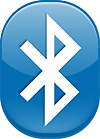 Bluetooth is a wireless technology standard for exchanging data over short distances using radio transmissions. Bluetooth operates in the unlicensed industrial, scientific and medical (ISM) band at 2.4 to 2.485 GHz, using a spread spectrum, frequency hopping, full-duplex signal at a nominal rate of 1600 hops/sec.
Bluetooth is a wireless technology standard for exchanging data over short distances using radio transmissions. Bluetooth operates in the unlicensed industrial, scientific and medical (ISM) band at 2.4 to 2.485 GHz, using a spread spectrum, frequency hopping, full-duplex signal at a nominal rate of 1600 hops/sec.
Created by Ericsson in 1994, Bluetooth wireless technology was originally conceived as a wireless alternative to RS-232 data cables. In 1998, the original group of promoter companies—Ericsson, Intel, Nokia, Toshiba and IBM—came together to form the Bluetooth Special Interest Group (SIG) and work together to preserve, educate, and further Bluetooth technology as a means to bring devices into the connected world.
The name Bluetooth comes from the 10th century Danish King Harald Blåtand or Harold Bluetooth in English. King Blåtand helped unite warring factions in parts of what are now Norway, Sweden and Denmark. Similarly, Bluetooth technology was created as an open standard to allow connectivity and collaboration between disparate products and industries.
Back to Top A type of connector that uses a twist and lock type of retention. No one knows what BNC stands for, but there are several theories, including British Naval Connector, Bayonet Nut Connector, and Bayonet Neill Concelman (named for the alleged creators of the connector). Of the three, the latter seems to be the most feasible.
A type of connector that uses a twist and lock type of retention. No one knows what BNC stands for, but there are several theories, including British Naval Connector, Bayonet Nut Connector, and Bayonet Neill Concelman (named for the alleged creators of the connector). Of the three, the latter seems to be the most feasible.
BNC connectors terminate to coaxial cable and are commonly used with video and radio communication equipment, and also older Ethernet networks.
Back to TopAn electronic device used to increase the power of a signal. The booster has one or more inputs, and one or more outputs. The signals coming in are gathered, given a power boost, and sent to the output. Boosters are used to send signals a greater distance than they could reasonably travel on their own. Booster also refers to a component of an audio/video system that collects line-level signals, processes them, boosts them, and sends the high-level signal to the target destination.
Back to TopA method of communication in which a signal is transmitted by being impressed to a higher frequency carrier wave. This allows more data to be carried for a longer distance.
Back to TopUsed to refer to cable or items that are purchased in large amounts. Bulk cable is cable sold in a large roll, typically in 100 ft or higher increments. Bulk cable can also refer to raw, unfinished cable (a cable with no connectors).
Back to TopBring Your Own Device (BYOD) refers to the policy of permitting employees to bring personally owned mobile devices (laptops, tablets, and smartphones) to their workplace, and to use those devices to access privileged company information and applications. The term is also used to describe the same practice applied to students using personally owned devices in education settings.
The term BYOD first entered common use in 2009, courtesy of Intel when it recognized an increasing tendency among its employees to bring their own devices (i.e., smartphones, tablets and laptop computers) to work and connect them to the corporate network.
BYOD has been characterized as the feature of the "consumer enterprise" in which enterprises blend with consumers. This is a role reversal in that businesses used to be the driving force behind consumer technology innovations and trends.
The BYOD idea was initially rejected due to security concerns but more and more companies are now looking to incorporate BYOD policies. The proliferation of devices such as tablets and smartphones, which are now used by many people in their daily lives, has led to a number of companies allowing employees to bring their own devices to work, due to perceived productivity gains and cost savings.
The most significant challenge companies face regarding BYOD is how to enable security in a way that doesn't freak employees out but still gives information technology departments enough control, with many users currently unaware or unmotivated about security risks.
Back to Top8 bits combined into a logical unit. A byte typically represents a single character in a computer system such as the letter "A" or the number "4".
Back to Top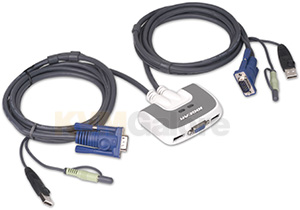 Cable KVM switch is a KVM switch with an all-in-one design, incorporating a diminutive size and built-in (molded) cables.
Cable KVM switch is a KVM switch with an all-in-one design, incorporating a diminutive size and built-in (molded) cables.
Because of its small size, a cable KVM switch is typically used to control only two computers (and no more than four), therefore typically deployed at SOHO or digital living room setting.
The all-in-one design and small footprint, however, make a cable KVM switch easy to install in convenient, out of sight location for a neat, unobtrusive setup.
Back to Top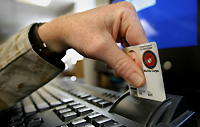 Common Access Card (CAC) is a United States Department of Defense (DoD) smart card issued as standard identification for active-duty military personnel.
Common Access Card (CAC) is a United States Department of Defense (DoD) smart card issued as standard identification for active-duty military personnel.
CAC is used as a general identification card as well as for authentication to enable access to DoD computers, networks, and certain DoD facilities. It also serves as an identification card under the Geneva Conventions.
CAC enables encrypting and cryptographically signing email, facilitating the use of PKI authentication tools, and establishes an authoritative process for the use of identity credentials.
Back to Top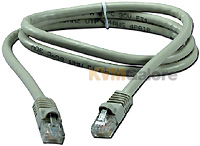 [Also known as Category 5/5e Cable] A twisted pair cable type designed for high signal integrity. Many such cables are unshielded but some are shielded.
[Also known as Category 5/5e Cable] A twisted pair cable type designed for high signal integrity. Many such cables are unshielded but some are shielded.
Category 5 has been superseded by the Category 5e specification. This type of cable is often used in structured cabling for computer networks such as Ethernet, and is also used to carry many other signals such as KVM, A/V and USB.
Category 5 cable includes four twisted pairs in a single cable jacket. This use of balanced lines helps preserve a high signal-to-noise ratio despite interference from both external sources and other pairs (this latter form of interference is called crosstalk). It is most commonly used for Ethernet networks and extender systems.
CAT- 5 cable typically has three twists per inch of each twisted pair of 24 gauge copper wires within the cable.
Back to Top [Also known as Category 6 Cable] A cable standard for Gigabit Ethernet and other network protocols that is backward compatible with the Category 5/5e and Category 3 cable standards.
[Also known as Category 6 Cable] A cable standard for Gigabit Ethernet and other network protocols that is backward compatible with the Category 5/5e and Category 3 cable standards.
CAT-6 features more stringent specifications for crosstalk and system noise. The cable standard provides performance of up to 250 MHz and is suitable for 10BASE-T/100BASE-TX and 1000BASE-T (Gigabit Ethernet). It is expected to suit the 10GBASE-T (10Gigabit Ethernet) standard, although with limitations on length if unshielded CAT- 6 cable is used.
The cable contains four twisted copper wire pairs, just like earlier copper cable standards. CAT-6 is sometimes made with 23 gauge wire, but may be made with 22 to 24 AWG gauge wire, so long as the cable meets the specified testing standards. When used as a patch cable, CAT-6 is normally terminated with modular connectors referred to as "RJ45" electrical connectors.
Back to Top[Also known as Category 7 Cable] A cable standard for Ethernet and other interconnect technologies that can be made to be backwards compatible with traditional CAT-5 and CAT-6 Ethernet cable.

CAT-7 features even more strict specifications for crosstalk and system noise than CAT-6. To achieve this, shielding has been added for individual wire pairs and the cable as a whole. The CAT-7 cable standard has been created to allow 10 gigabit Ethernet over 100m of copper cabling.
The cable contains four twisted copper wire pairs, just like the earlier standards. CAT-7 can be terminated either with RJ45 compatible electrical connectors which incorporate the RJ45 standard or with TERA connectors. When combined with GG-45 or TERA connectors, CAT-7 cable is rated for transmission frequencies of up to 600 MHz.
Back to TopCable Television. Refers to equipment or technologies used to transmit, receive, or carry cable television signals. CATV cables typically use the F-type connector terminated to 75 Ohm coaxial cable.
Back to TopClosed-Circuit Television. A system where video (and sometimes audio) is directly transmitted to specific users and not broadcast to the general public. Most often used for security systems.
Back to TopConsumer Electronics Control (CEC) is an HDMI feature designed to allow the user to command and control up-to 15 CEC-enabled devices, that are connected through HDMI, by using only one of their remote controls.
Example: by controlling a television set, set-top box, and DVD player using only the remote control of the TV.
CEC is an optional protocol used in HDMI systems that allows HDMI devices to pass control functions along to all devices within the system. CEC also allows for individual CEC-enabled devices to command and control each other without user intervention.
Technically, CEC is a one-wire bidirectional serial bus that is based on the CENELEC standard AV.link protocol to perform remote control functions. CEC wiring is mandatory in HDMI, although implementation of CEC in a product is optional. CEC was defined in HDMI specification 1.0 and updated in HDMI 1.2, HDMI 1.2a and HDMI 1.3a (which added timer and audio commands to the bus). USB to CEC adapters exist that allow a computer to control CEC-enabled devices.
Trade names for CEC may include Anynet+ (Samsung), Aquos Link (Sharp), BRAVIA Link and BRAVIA Sync (Sony), HDMI-CEC (Hitachi), E-link (AOC), Kuro Link (Pioneer), INlink (Insignia), CE-Link and Regza Link (Toshiba), RIHD (Remote Interactive over HDMI) (Onkyo), RuncoLink (Runco International), SimpLink (LG), T-Link (ITT), HDAVI Control, EZ-Sync, VIERA Link (Panasonic), EasyLink (Philips), and NetCommand for HDMI (Mitsubishi).
The following is a list of the most commonly used HDMI-CEC commands:
- One Touch Play allows devices to switch the TV to use it as the active source when playback starts
- System Standby enables users to switch multiple devices to standby mode with the press of one button
- Preset Transfer transfers the tuner channel setup to another TV set
- One Touch Record allows users to record whatever is currently being shown on the HDTV screen on a selected recording device
- Timer Programming allows users to use the electronic program guides (EPGs) that are built into many HDTVs and set-top-boxes to program the timer in recording devices like PVRs and DVRs
- System Information checks all components for bus addresses and configuration
- Deck Control allows a component to interrogate and control the operation (play, pause, rewind etc.), of a playback component (Blu-ray or HD DVD player or a Camcorder, etc.)
- Tuner Control allows a component to control the tuner of another component
- OSD Display uses the OSD of the TV set to display text
- Device Menu Control allows a component to control the menu system of another component by passing through the user interface (UI) commands
- Routing Control controls the switching of signal sources
- Remote Control Pass Through allows remote control commands to be passed through to other devices within the system
- Device OSD Name Transfer transfers the preferred device names to the TV set
- System Audio Control allows the volume of an AV receiver, integrated amplifier or preamplifier to be controlled using any remote control from a suitably equipped device(s) in the system
Chroma subsampling is a practice of encoding images by compressing their color information in order to reduce the overall storage size and bitrate of video files.
An electronic image is composed of pixels. Pixels have different attributes:
- Chroma attribute: color value, representing the color information.
- Luma (luminance) attribute: brightness value, representing the brightness (luminance) in an image (the "black-and-white" portion of the image), creating contrast and detail within the overall image.

If you take all the chroma out of a picture, you're left with a black-and-white image. The image would be grayscale, as there are variable depths of contrast between pure black and pure white.
If you take all the luminance out of an image, you're left with no image at all.
To accomplish a good quality image, each pixel must have its own luma data, but it doesn't necessarily need to have its own chroma data. Chunks of pixel can share the same chroma data and still produce a pretty good image.
Chroma subsampling is a practice of encoding images by having some pixels share the same chroma data (while keeping the luma data for each pixel in tact). Chroma subsampling is used in many video encoding schemes - both analog and digital - and also in JPEG encoding.
Chroma subsampling practice takes advantage of the human visual system which is more sensitive to the luminance, the brightness and contrast portion of an image and less sensitive to the chroma, color information of an image.
The number of pixels sharing the same chroma data determines how much subsampling is being done. How much color-information compression happens is often expressed as a set of numbers patterned: 'J:a:b' (e.g. 4:2:0).
'J' represents the number of pixels we're dealing with - how many pixels wide is the reference block for the sampling pattern (usually 4 pixels wide).
'a' represents the number of pixels in the top 'a' row which are getting chroma samples.
'b' represents the number of pixels in the bottom 'b' row which are getting chroma samples.
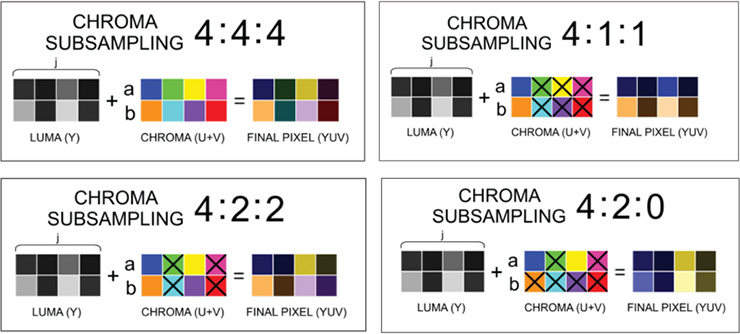
If every pixel in the 4x2 grid gets a chroma sample, there's actually no subsampling taking place, a situation represented by the 4:4:4 expression.
Back to TopMaterial that surrounds the core of an optical fiber. It blocks the light from "leaking" out of the core, causing the transmitted light to travel down the core.
Back to TopA computer on a network. A client is a computer or application that relies on a server to perform some operation. See Client/Server.
Back to TopA network architecture which dedicates each computer on the network as a client or a server. Clients rely on servers for resources, such as files, devices, and even processing power. Client/Server architectures are typically more expensive and complex, but they have distinct advantages over peer-to-peer networks. Having files in a central location, for example, makes them easier for all the clients to access and makes it easier for them to be archived. Putting shared devices on a server (such as printers) saves cost by allowing multiple clients to share that single device. Running applications for a central server saves costs because the client machines do not have to be as powerful as the server machine.
Back to Top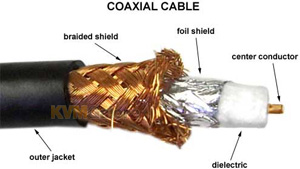 [Also known as Coaxial] A type of cable composed of a center conductor inside a metal tube or shield. A dielectric material separates the center conductor from the shield, which is covered by an insulating jacket.
[Also known as Coaxial] A type of cable composed of a center conductor inside a metal tube or shield. A dielectric material separates the center conductor from the shield, which is covered by an insulating jacket.
Coaxial is a popular cable for video because it is highly resistance to signal loss and interference, and can carry a large amount of bandwidth.![]()
 Common Criteria is an international standard for computer security certification; the driving force for the widest available mutual recognition of secure IT products.
Common Criteria is an international standard for computer security certification; the driving force for the widest available mutual recognition of secure IT products.
The Common Criteria for Information Technology Security Evaluation (CC), is the technical basis for an international agreement which ensures that products can be evaluated as to determine the fulfillment of particular security properties, to a certain extent or assurance.
Common Criteria is a framework in which computer system users can specify their security functional and assurance requirements through the use of protection profiles; vendors, in turn, can then implement and/or make claims about the security attributes of their products; testing laboratories can evaluate the products to determine if they actually meet the claims.
In other words, Common Criteria provides an assurance that the process of specification, implementation and evaluation of a computer security product has been conducted in a rigorous and standard and repeatable manner at a level that is commensurate with the target environment for use.
Common Criteria is used as the basis for a Government driven certification scheme and typically evaluations are conducted for the use of Federal Government agencies, the military and critical infrastructure.
Back to Top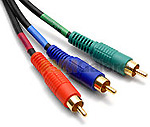
 One of the highest quality types of analog video signals, commonly used for Hi-Definition Television (HDTV).
One of the highest quality types of analog video signals, commonly used for Hi-Definition Television (HDTV).
Component video separates the signal into three elements or components; the luminance or picture signal, and two color signals. The three signals are carried on their own conductor, so Component video cables are three cables with RCA or BNC connectors colored Red, Green, and Blue.
Back to Top The lowest common denominator video signal, found on virtually all consumer grade video hardware today.
The lowest common denominator video signal, found on virtually all consumer grade video hardware today.
Composite video combines all the picture information into a single signal. The connector type used is RCA, and it is typically colored yellow.
Back to Top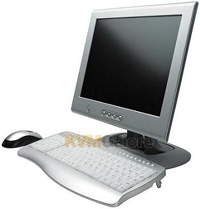 A set of peripherals that allow accessing and controlling a computer, typically consisting of a monitor, a keyboard and a mouse.
A set of peripherals that allow accessing and controlling a computer, typically consisting of a monitor, a keyboard and a mouse.
A device that converts a signal from one type to another type. If the only change is in the physical connection type, it is more appropriate to use the term "Adapter".
Back to Top A special type of adapter used to join two cables together that have the same connector type. For example, if you have two six-foot cables you can use a coupler to join them together to get a twelve-foot cable.
A special type of adapter used to join two cables together that have the same connector type. For example, if you have two six-foot cables you can use a coupler to join them together to get a twelve-foot cable.
A type of pin to conductor termination method. Crimp pins have little teeth or flanges that are pressed or pinched into the conductor to make electrical contact.
Back to Top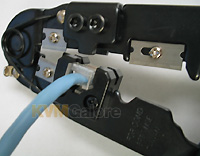
 A tool used to affix a crimp pin or connector housing to the conductors in a cable.
A tool used to affix a crimp pin or connector housing to the conductors in a cable.
A problem that occurs in a cable by which a signal transmitted on one circuit or channel of a transmission system creates an undesired effect (interference) in another circuit or channel.
Back to Top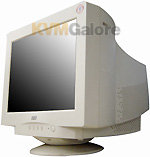 Cathode Ray Tube (CRT) is a vacuum tube containing an electron gun (a source of electrons) and a fluorescent screen, with internal or external means to accelerate and deflect the electron beam, used to form images in the form of light emitted from the fluorescent screen. CRT is used (among other applications) as a video display for televisions and computer monitors.
Cathode Ray Tube (CRT) is a vacuum tube containing an electron gun (a source of electrons) and a fluorescent screen, with internal or external means to accelerate and deflect the electron beam, used to form images in the form of light emitted from the fluorescent screen. CRT is used (among other applications) as a video display for televisions and computer monitors.
The CRT uses an evacuated glass envelope which is large, deep, heavy, and relatively fragile. Display technologies without these disadvantages, such as flat plasma screens, liquid crystal displays (LCD), DLP, OLED displays have replaced CRTs in many applications and are becoming increasingly common as costs decline.
Back to TopCascading Style Sheets (CSS) is a style sheet language used for describing the presentation semantics (the look and formatting) of a document written in a markup language. Its most common application is to style Web pages written in HTML.
CSS is designed primarily to enable the separation of document content (written in HTML or a similar markup language) from document presentation, including elements such as the layout, colors, and fonts. This separation can improve content accessibility, provide more flexibility and control in the specification of presentation characteristics, enable multiple pages to share formatting, and reduce complexity and repetition in the structural content (such as by allowing for tableless Web design).
CSS can also allow the same markup page to be presented in different styles for different rendering methods, such as on-screen, in print, by voice (when read out by a speech-based browser or screen reader) and on Braille-based, tactile devices. It can also be used to allow the Web page to display differently depending on the screen size or device on which it is being viewed. While the author of a document typically links that document to a CSS file, readers can use a different style sheet, perhaps one on their own computer, to override the one the author has specified.
CSS specifies a priority scheme to determine which style rules apply if more than one rule matches against a particular element. In this so-called cascade, priorities or weights are calculated and assigned to rules, so that the results are predictable.
Back to TopRefers to the shape (D) and size (Sub or Subminiature) of the connector. D-Sub (db) connectors are the most common type of connector used on computers and electronics equipment.
Back to TopUsed as a prefix for d-shaped connectors, such as the db-9 or db25. Short form of D-Sub.
Back to TopDirect Current. An electric current flowing in one direction only and substantially constant in value. Electric batteries use DC.
Back to TopShort form for Display Data Channel. It is a VESA standard for communication between a monitor and a video adapter. DDC is what enables plug and play connection between a computer's video card and a monitor.
Using DDC, a monitor can inform the video card about its properties, such as maximum resolution and color depth (i.e. supported resolutions, manufacturer, phosphor/filter type, display size, luninance data and in the case of digital panels - pixel mapping). The video card can then use this information to ensure that the user is presented with valid options for configuring the display.
Back to TopDigital Display Working Group (DDWG) - an industry consortium which is the creator of the DVI specification.
Back to TopLogarithmic scale measuring the intensity of sound (the sound pressure level); a 10 decibel (dB) increase represents in a doubling of sound level. Also used as the unit of measure for attenuation.
Back to TopDeep Color is an HDMI 1.3 feature that increases the precision of brightness and color information sent to the display. It may use 10, 12, or 16-bit precision values per color (Red, Green, and Blue) - up from 8-bits per color used in older systems, for stunning rendering of over one billion colors in unprecedented detail.
Back to TopA piece of software that acts as a translator between the computer and the device allowing the two to communicate.
Back to TopAudio signals that are converted to a digital format. Digital audio provides a cleaner signal because it is immune to interference and provides a more accurate representation of the source material. The digital format also allows a tremendous amount of information to be sent over a single cable, such as a complete 5.1 surround presentation.
Back to Top Digital audio over a thin glass or plastic fiber optic cable. Digital optical has a length limitation of about 5 meters. Also called TOSLink.
Digital audio over a thin glass or plastic fiber optic cable. Digital optical has a length limitation of about 5 meters. Also called TOSLink.
A form of out-of-home advertising in which content and messages displayed on an electronic screen, or digital sign, can be changed without modification to the physical sign, typically with the goal of delivering targeted messages to specific locations at specific times. Digital signs may be scrolling message boards, LCD or plasma display panels, electronic billboards, projection screens, or other emerging display types like living surfaces or Organic LED screens (OLEDs) that can be controlled electronically using a computer or other devices, allowing individuals or groups to remotely change and control their content.
Back to TopStands for Deutsches Institut für Normung, or German Institute for Standardization, a manufacturing industry standards group. DIN refers to a round connector with pins arranged in a circular fashion, and is commonly used for keyboards, MIDI instruments, and other devices. See also Mini-DIN.
Back to Top
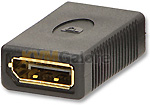
DisplayPort (DP) is a digital display interface developed by a consortium of PC and chip manufacturers and standardized by the Video Electronics Standards Association (VESA). It is primarily used to connect a video source to a display device such as a computer monitor. DisplayPort is able to transmit audio and video simultaneously, although each can be transmitted without the other.
Royalty-free, DisplayPort was designed to replace VGA and DVI, and it is backward-compatible with them – as well as HDMI - through the use of adapters.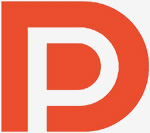
Originally released in 2006, DisplayPort 1.0 supports resolutions up to 2560x1600 @ 60Hz.
In 2007, DisplayPort 1.1 added support for Dual-Mode DisplayPort, which allows it to be used with DVI and HDMI displays. It also added support for 4K @ 30Hz video resolution, and HDCP 1.3.
DisplayPort 1.2 was released in 2010, adding support for 4K video resolution and higher refresh rates. It supports resolutions up to 4096x2160 @ 60Hz and 2560x1600 @ 120Hz. It also added support for Display Stream Compression (DSC) - a lossless compression format that opens up a wider range of resolutions and refresh rates than its bandwidth might otherwise allow. Apple Inc.'s Mini DisplayPort connector, which is much smaller and designed for laptop computers and other small devices, is compatible with DisplayPort 1.2.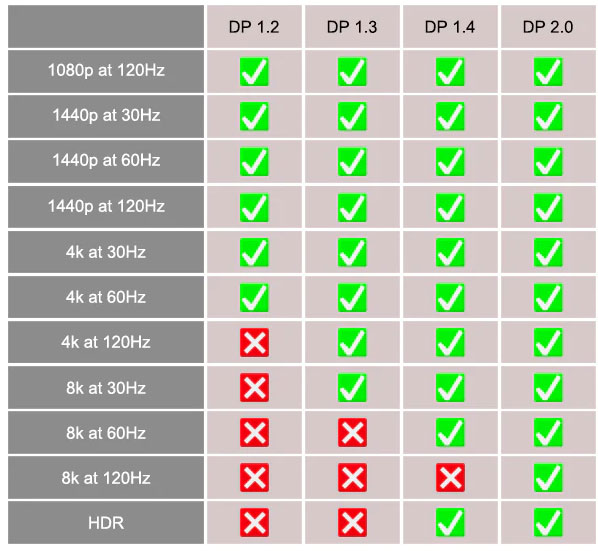
DisplayPort 1.3 was released in 2014, adding support for HDR (High Dynamic Range) and increased the maximum bandwidth to 32.4 Gbps. It also added support for Multi-Stream Transport (MST), which allows multiple displays to be connected to a single DisplayPort output.
DisplayPort 1.4 was released in 2016 and supports both 4K and 8K monitor resolutions with the ability for refresh rates to hit 120 Hz. Support for HDR10 was also implemented.
DisplayPort 2.0 was launched in 2019, adding support for up to 16K @ 60Hz video resolution. The effective bandwidth was juiced up to 77.4 Gbps while implementing the latest Ultra High Bit Rate (UHBR) and supporting Dynamic HDR.
Also see: Multi-Stream Transport (MST)
Back to Top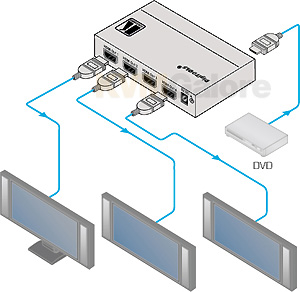 Typically referring to video and audio/video (A/V), a distribution amplifier (DA, also called a splitter) is a device that takes one video (or A/V) input signal, amplifies it and simultaneously sends it to multiple outputs, with each destination receiving the same signal.
Typically referring to video and audio/video (A/V), a distribution amplifier (DA, also called a splitter) is a device that takes one video (or A/V) input signal, amplifies it and simultaneously sends it to multiple outputs, with each destination receiving the same signal.
The signal source could be a DVD player, a set top box, or any other video or audio/video source. The multiple outputs would typically be video screens.
In effect, a distribution amplifier duplicates the input signal (from the source) and displays it as identical video on multiple displays.
Distribution amplifiers (DAs) may support the target destinations being in proximity to the source, or being far away from the source, typically using CAT-5 cable as means of connecting the source to the destination.
Back to Top The implementation of surround sound that is encoded to a digital signal. Dolby Digital is a compression method for encoding up to 5.1 channels of audio into a digital audio signal using a minimum of bandwidth.
The implementation of surround sound that is encoded to a digital signal. Dolby Digital is a compression method for encoding up to 5.1 channels of audio into a digital audio signal using a minimum of bandwidth.
Dolby Digital is widely available and is the de-facto standard on DVDs today. Named for the company that invented the technology, Dolby Laboratories.
Back to Top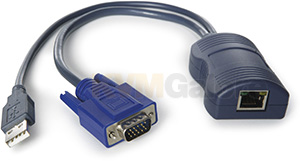
A KVM dongle is a small piece of hardware that attaches to a computer's KVM (keyboard, video, mouse) ports, facilitating the use of CATx (CAT-5/5e/6/7) cables to connect the computer to a KVM switch or to a KVM extender.
A dongle is typically a small plastic enclosure containing electronics designed to boost the KVM signal. Short cables (or one cables with additional pigtail[s]) coming out of one side of the dongle have KVM connectors at their end to connect to the computer's KVM (keyboard, video, mouse) ports. These connectors, for example, may be VGA or DVI for video; USB or PS/2 for keyboard/mouse. An RJ45 female connector on the other end is used to connect a standard CATx cable running to a KVM switch or a KVM extender receiver.
Facilitating the use of CATx cables instead of traditional coax cables to connect computers to KVM switches/extenders, KVM dongles offer quite a few advantages:
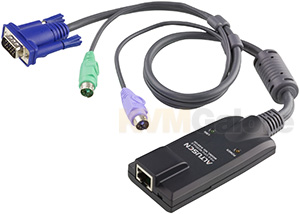
- Support for longer distance
- Support flexible deployment using standard IT infrastructure
- Better cable management with thinner, less bulky and less cumbersome to handle cables
- Higher density appliances (greater port-count) due to smaller RJ45 connectors
- Easy hardware interchangeability due to the use of standard RJ45 connectors
- Custom cables length created ad-hoc since CATx cables are easily cut and terminated to any desired length on-site
Although all KVM dongles use standard CATx cables, their electronics are proprietary and specified to be used only with dedicated KVM appliances, making them incompatible with competing-brand hardware.
Back to TopDigital Rights Management (DRM) is an umbrella term that refers to access control technologies used by publishers and other copyright holders to limit usage of digital media or devices. DRM can also refer to restrictions associated with specific instances of digital works or devices. The term is often confused with copy protection and technical protection measures, which refer to specific technologies that control or restrict the use and access of digital content on electronic devices. Such technologies act as components of a complete rights-management system design.
Back to TopDigital Subscriber Line. A type of broadband internet service that is carried over standard phone lines. DSL can typically provide speeds up to 1.5 Mbps, which is over 30 times greater than standard dial-up speeds.
Back to Top[Also known as Duplex Cable] A cable assembly with two separate cable paths, usually one transmit and one receive. Typically used in reference to fiber cables.
Back to Top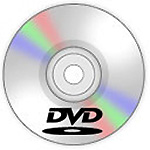 Digital Versatile Disc. A 5-inch optical disk that stores audio and video information. It is currently the most popular format for storing movies.
Digital Versatile Disc. A 5-inch optical disk that stores audio and video information. It is currently the most popular format for storing movies.
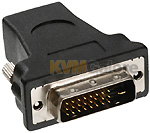
![]() Digital Visual Interface (DVI) is a video interface standard designed to maximize the visual quality of digital display devices such as flat panel LCD computer displays and digital projectors.
Digital Visual Interface (DVI) is a video interface standard designed to maximize the visual quality of digital display devices such as flat panel LCD computer displays and digital projectors.
It was developed by an industry consortium, the Digital Display Working Group (DDWG). It is designed for carrying uncompressed digital video data to a display. It is partially compatible with the High-Definition Multimedia Interface (HDMI) standard in digital mode (DVI-D).
As well as digital signals, the DVI-I connector also includes pins providing the same analog signals found on a VGA connector, allowing a VGA monitor to be connected with a simple adapter. This feature was included in order to make DVI universal, as it allows either type of monitor (analog or digital) to be operated from the same connector.
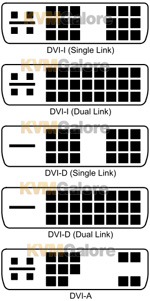 The DVI connector on a device is therefore given one of three names, depending on which signals it implements:
The DVI connector on a device is therefore given one of three names, depending on which signals it implements:
- DVI-D (digital only)
- DVI-A (analog only)
- DVI-I (digital and analog)
Single Link DVI describes the standard use of DVI, capable of resolutions up to 1920x1200.
The DVI connector may also includes provision for a second data link for high resolution displays. In this case, the connector is referred to as DVI-DL (Dual Link).
Dual link DVI describes the use of all 24 pins of the DVI connector to achieve high video resolutions of 2560x1600 @ 60Hz, or mega high video resolutions up to 3840x2400 @ 30Hz.
Back to TopAn Evaluation Assurance Level (EAL) is a category ranking (a numerical grade) assigned to an IT product or system after a Common Criteria security evaluation. The level indicates to what extent the product or system was tested. The increasing assurance levels reflect added assurance requirements that must be met to achieve Common Criteria certification. The intent of the higher levels is to provide higher confidence that the system's principal security features are reliably implemented.
A product or system must meet specific assurance requirements to achieve a particular EAL. Requirements involve design documentation, analysis and functional or penetration testing. The highest level provides the highest guarantee that the system's principal security features are reliably applied.
Although assurance requirements for each product and system are the same, functional requirements differ. The EAL level does not measure the security of the system itself, it simply states at what level the system was tested. Functional features are created in the Security Target document, which is specifically tailored for each product's evaluation. Therefore, a higher EAL does not indicate a higher level of security than a lower EAL because they may have different functional features in the Security Targets.
| EAL Level | Description |
| EAL 1 | Functionally tested |
| EAL 2 | Structurally tested |
| EAL 3 | Methodically tested and checked |
| EAL 4 | Methodically designed, tested and reviewed |
| EAL 5 | Semi-formally designed and tested |
| EAL 6 | Semi-formally verified design and tested |
| EAL 7 | Formally verified design and tested |
Extended Display Identification Data (EDID) is a VESA standard data format that contains basic information about a monitor and its capabilities, including vendor information, maximum image size, color characteristics, factory pre-set timings, frequency range limits, and character strings for the monitor name and serial number.
Back to TopElectromagnetic Interference. Any electronic device gives off an electrical field when it is operating. EMI is when the electrical field of one device interferes with the electrical field of another device. EMI is bad for a signal going through a cable as it can corrupt the signal, so to prevent EMI in a cable, a shield is used. Conversely, the shield also prevents the signal going through the wire from causing EMI in other devices.
Back to TopA network architecture and set of standards defined by the IEEE as the 802.3 specification. Ethernet is the standard way that computers get on the Internet and communicate with each other today. Ethernet has evolved over the years from bulky systems that only ran at 10 Mbps (megabits per second) to small fast systems that run at over 1 Gigabit (1000 Mbps). The most common cable used with Ethernet is the Cat5 patch cable, which uses the RJ-45 modular connector, but fiber optic cables can also be used.
Back to Top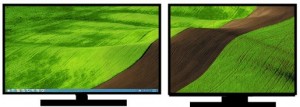 A feature in a computer that allows a user to extend viewing capabilities by using two or more monitors at the same time.
A feature in a computer that allows a user to extend viewing capabilities by using two or more monitors at the same time.
To connect more than one monitor to a computer, the user must have a computer with more than one monitor port (head). On most computers, you can add a monitor port by installing another graphics card. Graphics cards with multiple video outputs also support the same purpose.
Extended desktop mode allows the user to display a single document or application across multiple monitors, or use each monitor to display a different document or application. It also allows the monitors to have independent resolutions, color depth, and refresh rates.
Extended desktop is useful for presentations where the user wishes to display one screen to the audience while reading notes from another (hidden) screen. It is also used to view spreadsheets across several monitors so that all columns or rows can be seen without scrolling. Extended desktop is also useful in graphic and Web design to edit an HTML page on one monitor while viewing the rendered Web page on another.
Back to Top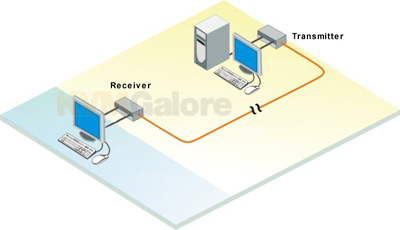 A device that extends an original signal or extends the capability of controlling an original device to a remote (extended) location, typically using standard CAT-5/5e/6/7 cable(s).
A device that extends an original signal or extends the capability of controlling an original device to a remote (extended) location, typically using standard CAT-5/5e/6/7 cable(s).
An extender typically consists of two (2) components: A (local) transmitter that connects to the source, and a (remote) receiver that resides at the extended location connecting to the target. The transmitter and the receiver are typically connected over a distance with a CAT-5 cable.
Extenders may include:
- Audio Extender – Extending speakers.
- Component Extender – Extending component video to a remote display.
- DVI Extender – Extending DVI video to a remote display.
- HDMI Extender – Extending HDMI signals to a remote HDTV display.
- KVM Extender – Extending a computer console consisting of a keyboard, video-monitor, and mouse.
- PS/2 Extender – Extending PS/2 peripherals (keyboard and mouse).
- RS232 Extender – Extending RS232 devices such as touch-screens.
- USB Extender – Extending USB devices such as cameras.
- Video Extender – Extending a video signal to a remote display.
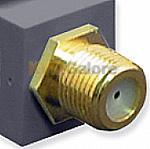
 A round, inside-threaded, barrel connector (also known as (F-Type Connector) used with coaxial cable and common for CATV use.
A round, inside-threaded, barrel connector (also known as (F-Type Connector) used with coaxial cable and common for CATV use.
 A type of conductor made of a fine thread of plastic or glass used to carry a signal that consists of pulses of light. Fiber Optic cables are capable of much greater bandwidth capacity than standard electrical cables, and can also go much greater distances without signal degradation.
A type of conductor made of a fine thread of plastic or glass used to carry a signal that consists of pulses of light. Fiber Optic cables are capable of much greater bandwidth capacity than standard electrical cables, and can also go much greater distances without signal degradation.
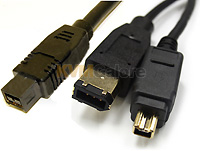 FireWire is Apple Inc.'s brand name for the IEEE 1394 interface (although the 1394 standard also defines a backplane interface). It is also known as i.Link (Sony's name). It is a personal computer (and digital audio/digital video) serial bus interface standard, offering high-speed communications and isochronous real-time data services. IEEE 1394 has been adopted as the High Definition Audio-Video Network Alliance (HANA) standard connection interface for A/V (audio/visual) component communication and control.
FireWire is Apple Inc.'s brand name for the IEEE 1394 interface (although the 1394 standard also defines a backplane interface). It is also known as i.Link (Sony's name). It is a personal computer (and digital audio/digital video) serial bus interface standard, offering high-speed communications and isochronous real-time data services. IEEE 1394 has been adopted as the High Definition Audio-Video Network Alliance (HANA) standard connection interface for A/V (audio/visual) component communication and control.
Almost all modern digital camcorders have included this connection since 1995. Many computers intended for home or professional audio/video use have built-in FireWire ports including all Apple, Sony laptop computers and most Dell and HP models currently produced. FireWire was used with initial models of Apple's iPod, but later models eliminated FireWire support in favor of USB due to space constraints and for wider compatibility.
4-pin IEEE 1394a-2000 FireWire connectors are typically found on camcorders and other digital A/V equipment.

6-pin IEEE 1394a FireWire 400 connectors are typically found on PCs (Apple especially) and disk systems.
9-pin IEEE 1394b FireWire 800 connectors (typically found on Apple computers) allow interconnection to older 1394a systems in 'bilingual mode' (4- or 6-pin using an appropriate adapter-cable).
Back to Top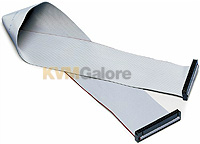 A type of cable named for its shape. The conductors are bonded together and laid flat in a ribbon-like configuration. Flat ribbon cables are commonly used for connection of internal computer peripherals.
A type of cable named for its shape. The conductors are bonded together and laid flat in a ribbon-like configuration. Flat ribbon cables are commonly used for connection of internal computer peripherals.
Flat ribbon cables are also designated by their number of conductors, such as 40-pin flat ribbon (40 conductors) or 50-pin flat ribbon (50 conductors). The type of connector used on a flat ribbon cable is typically the IDC.
Back to TopThe measure of the number of complete electrical cycles that occur within a specific period of time. Frequency is measured is Hertz (Hz), or cycles per second. See bandwidth.
Back to TopThe number of times a display can paint its screen with a complete image.
Back to TopA type of display that uses a CRT projected onto a large screen mounted to the wall or hanging from the ceiling. This is the type of system a movie theater uses.
Back to TopFile Transfer Protocol (FTP) is a standard network protocol used to transfer files from one host to another host over a TCP-based network, such as the Internet. FTP is commonly used to transfer Web page files or to download programs and other files to your computer from other servers.
FTP is built on a client-server architecture and uses separate control and data connections between the client and the server.
As a user, you can use FTP with a simple command line interface (for example, from the Windows MS-DOS Prompt window) or with a commercial program that offers a graphical user interface. Your Web browser can also make FTP requests to download programs you select from a Web page.
Using FTP, you can also update (delete, rename, move, and copy) files at a server. You need to logon to an FTP server. However, publicly available files are easily accessed using anonymous FTP.
FTP users may authenticate themselves using a clear-text sign-in protocol, normally in the form of a username and password, but can connect anonymously if the server is configured to allow it.
The first FTP client applications were command-line applications developed before operating systems had graphical user interfaces, and are still shipped with most Windows, Unix, and Linux operating systems. Dozens of FTP clients and automation utilities have since been developed for desktops, servers, mobile devices, and hardware, and FTP has been incorporated into hundreds of productivity applications, such as Web page editors.
Back to TopFull HD, also referred to as full HDTV, true HDTV, and 1080p, is a television (TV) display technology that surpasses the video quality and sharpness of the original high-definition television (HDTV) technology, providing an image resolution of 1920 by 1080 pixels with progressive scanning, at a frame-rate of 60 frames per second (60Hz).
Back to TopRefers to the orientation of the contacts on a connector as male or female. Male connectors typically have pins, and are called plugs. Female connectors typically have sockets, and are called jacks.
Back to TopA special type of adapter that simply changes the gender from male to female, or vice versa. Gender changers can also be used as couplers.
Back to TopH.264 (aka MPEG-4 AVC) is a video compression standard that is one of the most commonly used formats for the recording, compression, and distribution of video content. It is widely used in Blu-ray discs, internet sources like videos in YouTube, Vimeo, and iTunes, web software such as the Adobe Flash Player and Microsoft Silverlight, and also HDTV broadcasts over terrestrial, cable and satellite.
Approved in 2003 as the successor to MPEG-2 Part, and developed for use in high definition systems such as HDTV, Blu-ray and HD DVD as well as low resolution portable devices such as Sony’s PSP and Apple’s iPod, H.264 offers better quality at lower file sizes than its predecessor.
Currently, H.264 is gradually being replaced with the newer H.265 standard.
Back to TopH.265 (also known as HEVC, short for High Efficiency Video Coding) is a video compression standard whose predecessor is H.264. HEVC was designed to deliver video quality identical or better than to H.264, but with greater compression, so there's less data to deal with. This is key for 4K/Ultra-HD broadcasts, 4K Blu-rays, and more.
In most ways, H.265 HEVC is an extension of the concepts in H.264/MPEG-4 AVC. In comparison to H.264, it offers about double the data compression ratio at the same level of video quality, or substantially improved video quality at the same bit rate. It supports resolutions up to 8192×4320, including 8K Ultra-HD.
| H.265/HEVC | H.264/AVC | |
|---|---|---|
| Names | MPEG-H, HEVC, Part 2 | MPEG 4 Part 10, AVC |
| Approved date | 2013 | 2003 |
| Progression | Successor to H.264/AVC | Successor to MPEG-2 Part |
| Key improvement | * 40-50% bit rate reduction compared with H.264 at the same visual quality * It is likely to implement Ultra HD, 2K, 4K for Broadcast and Online (OTT) |
* 40-50% bit rate reduction compared with MPEG-2 Part * Available to deliver HD sources for Broadcast and Online |
| Support up to 8K | Yes | No. Support up to 4K. |
| Support up to 300 fps | Yes | No. support up to 59.94 fps only. |
In short: H.265 is the video compression standard of the future. Apple has already applied this technology to its iPhone 6 and larger iPhone 6 Plus for FaceTime over cellular. Other companies are urgently gearing up to launch H.265 converters to convert videos from/to H.265.
Back to Top HD DVD (short for High-Definition DVD) is a discontinued high-density optical disc format for storing data and high-definition video.
HD DVD (short for High-Definition DVD) is a discontinued high-density optical disc format for storing data and high-definition video.
Supported principally by Toshiba, HD DVD was envisioned to be the successor to the standard DVD format.
In February 2008, after a protracted format war with rival Blu-ray Disc, Toshiba abandoned the format, announcing it no longer developed or manufactured HD DVD players or drives.
Back to Top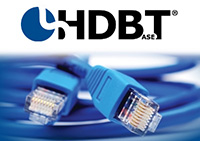 HDBaseT is a consumer electronic (CE) connectivity technology optimized for long-distance multimedia distribution, transmitting HD video, audio, Ethernet, power and control signals over a single CAT-5/6a cable (up to 100m/328ft) with RJ45 connectors.
HDBaseT is a consumer electronic (CE) connectivity technology optimized for long-distance multimedia distribution, transmitting HD video, audio, Ethernet, power and control signals over a single CAT-5/6a cable (up to 100m/328ft) with RJ45 connectors.
HDBaseT supports Full HD uncompressed video, 100BaseT Ethernet, and control signals including IR, CEC, and RS-232. Up to 100W of power can be extended over HDBaseT, to power remote devices.
Back to TopHigh-bandwidth Digital Content Protection (HDCP) is a form of Digital Rights Management (DRM) developed by Intel Corporation to control digital audio and video content as it travels across Digital Visual Interface (DVI) or High-Definition Multimedia Interface (HDMI) connections.
The specification is proprietary, and creating an implementation of HDCP requires a license. HDCP is used with HDTV signals over DVI and HDMI connections and on D-Theater D-VHS recordings to prevent unauthorized duplication of copy written material.
Back to Top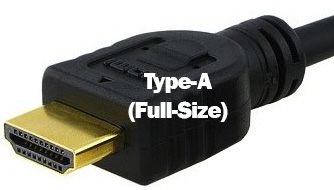 High-Definition Multimedia Interface (HDMI) is a licensable, all-digital audio/video interface capable of transmitting uncompressed streams.
High-Definition Multimedia Interface (HDMI) is a licensable, all-digital audio/video interface capable of transmitting uncompressed streams.
HDMI provides an interface between any compatible digital audio/video source such as a set-top box, a DVD player, a PC, a video game console, or an A/V receiver and a compatible digital audio and/or video monitor, such as a high-definition television (HDTV).
There are five HDMI connector types, but only three of them are commonly used in computers and consumer-electronic products:
Type-A: Full-Size
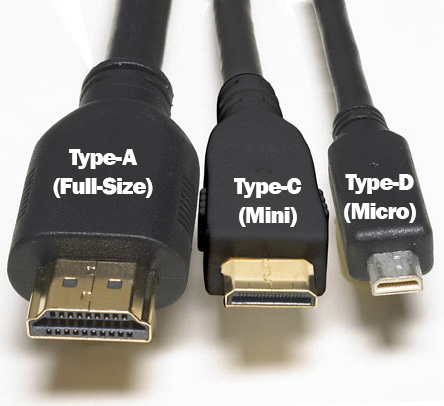 The full-size connector found on many home theater/consumer electronics devices such as TVs and computers, HDMI Type-A uses a 19-pin with bandwidth to carry all HDTV modes.
The full-size connector found on many home theater/consumer electronics devices such as TVs and computers, HDMI Type-A uses a 19-pin with bandwidth to carry all HDTV modes.
Defined in the HDMI 1.0 specification, HDMI Type-A plug (male) connector's outside dimensions are 13.9mm × 4.45mm, and the receptacle (female) connector inside dimensions are 14mm × 4.55mm.
Type-C: Mini
Fully compatible with the full-size Type-A, HDMI Type-C Mini connector is smaller than the Type-A plug, measuring only 10.42mm × 2.42mm.
Defined in the HDMI 1.3 specification, the Mini HDMI connector has the same 19-pin configuration as the full-size HDMI Type-A connector, and is intended for use with portable electronic devices.
HDMI Type-C Mini connector can be connected to a full-size HDMI Type-A connector using a type A-to-type C adapter-cable.
Type-D: Micro
Fully compatible with both the full-size Type-A and the Mini Type-C, HDMI Type-D Micro connector is the smallest of the two, with its plug measuring only 6.4mm × 2.8mm (similar in size to the Micro-USB connector).
Intended for use with portable electronic devices, HDMI Type-D Micro connector keeps the standard 19 pins of types A and C, but the pin assignment is different from both. HDMI Type-D Micro connector was defined in the HDMI 1.4 specification.
Just as the Mini-HDMI, HDMI Type-D Micro connector can be connected to a full-size HDMI Type-A connector using a type A-to-type C adapter-cable.
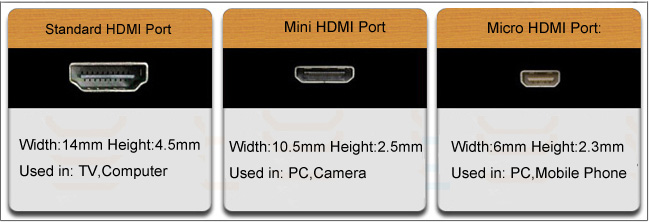
Type-B (rarely used)
Defined in the HDMI 1.0 specification, the large HDMI Type-B plug is 21.2mm × 4.45mm in size and has 29 pins, carrying six differential pairs instead of three, for use with very high-resolution displays. From a video point of view it is electrically compatible with dual-link DVI-D, but has rarely been used in any products (and appears to be replaced in the market place by DisplayPort).
Type-E (for automotive applications)
Defined in the HDMI 1.4 specification, HDMI Type-E - the Automotive Connection System - has a locking tab to keep the cable from vibrating loose and a shell to help prevent moisture and dirt from interfering with the signals. A relay connector is available for connecting standard consumer cables to the automotive type.
Back to TopWith the advent of Blu-ray Disc and HD DVD, HDMI version 1.3 includes improvements in both audio and video capability.
- Higher speed: Although all previous versions of HDMI have had more than enough bandwidth to support all current HDTV formats, including full, uncompressed 1080p signals, HDMI 1.3 increases its single-link bandwidth to 340 MHz (10.2 Gbps) to support the demands of future HD display devices, such as higher resolutions, Deep Color and high frame rates. In addition, built into the HDMI 1.3 specification is the technical foundation that will let future versions of HDMI reach significantly higher speeds.
- Deep Color: HDMI 1.3 supports 10-bit, 12-bit and 16-bit (RGB or YCbCr) color depths, up from the 8-bit depths in previous versions of the HDMI specification, for stunning rendering of over one billion colors in unprecedented detail.
- Broader color space: HDMI 1.3 adds support for "x.v.Color™" (which is the consumer name describing the IEC 61966-2-4 xvYCC color standard), which removes current color space limitations and enables the display of any color viewable by the human eye.
- New mini connector: With small portable devices such as HD camcorders and still cameras demanding seamless connectivity to HDTVs, HDMI 1.3 offers a new, smaller form factor connector option.
- Lip Sync: Because consumer electronics devices are using increasingly complex digital signal processing to enhance the clarity and detail of the content, synchronization of video and audio in user devices has become a greater challenge and could potentially require complex end-user adjustments. HDMI 1.3 incorporates automatic audio synching capabilities that allows devices to perform this synchronization automatically with total accuracy.
- New HD lossless audio formats: In addition to HDMI's current ability to support high-bandwidth uncompressed digital audio and all currently-available compressed formats (such as Dolby® Digital and DTS®), HDMI 1.3 adds additional support for new lossless compressed digital audio formats Dolby TrueHD and DTS-HD Master Audio™.
HDMI version 1.4 adds practical enhancements for HDMI connectivity.
- HDMI Ethernet Channel - The HDMI 1.4 specification adds a data channel to the HDMI connection, enabling high-speed, bi-directional communication. Connected devices that include this feature can send and receive data via 100 Mb/sec Ethernet, making them instantly ready for any IP-based application. The HDMI Ethernet Channel allows internet-enabled HDMI devices to share an internet connection via the HDMI link, with no need for a separate Ethernet cable. It also provides the connection platform that will allow HDMI-enabled components to share content between devices.
- Audio Return Channel - The new specification adds an audio channel that will reduce the number of cables required to deliver audio "upstream" from a TV to an A/V receiver for processing and playback. In cases where a TV features an internal content source, such as a built-in tuner or DVD player, the Audio Return Channel allows the TV to send audio data upstream to the A/V receiver via the HDMI cable, eliminating the need for an extra cable.
- 3D - The 1.4 version of the specification defines common 3D formats and resolutions for HDMI-enabled devices, enabling 3D gaming and other 3D video applications. The specification standardizes the input/output portion of the home 3D system, facilitating 3D resolutions up to dual-stream 1080p.
- 4K Resolution Support - The new specification enables HDMI devices to support extremely high HD resolutions, effectively four times the resolution of a 1080p device. Support for 4K allows the HDMI interface to transmit digital content at the same resolution as the state-of-the-art Digital Cinema systems used in many movie theaters.
- Expanded Support For Color Spaces - HDMI now supports color spaces designed specifically for digital still cameras, enabling more accurate color rendering when viewing digital photos. By supporting sYCC601, Adobe®RGB, and Adobe®YCC601, HDMI display devices are capable of displaying more accurate, life-like colors when connected to a digital camera.
- HDMI Micro Connector (Type D) - The HDMI Micro Connector is a significantly smaller 19-pin HDMI connector supporting up to 1080p resolutions for portable devices such as cell phones, portable media players, and digital cameras. This new connector is approximately 50% smaller than the size of the existing HDMI Mini connector.
- Automotive Connection System (Type E) - The Automotive Connection System is a cabling specification designed to be used for in-vehicle HD content distribution. The HDMI 1.4 specification provides a solution designed to meet the rigors and environmental issues commonly found in automobiles, such as heat, vibration and noise. Using the Automotive Connection System, car manufacturers now have a viable solution for HD distribution within a vehicle.
HDMI 2.0 improves on HDMI 1.4 (which was released back in 2009), primarily providing increased bandwidth to better support Ultra HD and 4K.
HDMI 2.0 enhancements and features include:
- Bandwidth (throughput) capacity is increased from 10.2Gbps (HDMI 1.4) to 18Gbps
- 4K Ultra HD at 50/60Hz - i.e. 2160p50 and 2160p60 - four times the clarity of 1080p60
- Up to 32 uncompressed digital audio channels (compared to HDMI 1.4's eight)
- Up to 1536kHz audio sampling
- Simultaneous delivery of dual video streams to multiple users (on the same screen)
- Simultaneous delivery of multi-stream audio to multiple users (up to four)
- Support for 21:9 aspect ratios
- Dynamic synchronization of video and audio streams
- Additional CEC extensions for remote controls
HDMI 2.0 is fully backwards compatible with HDMI 1.4 and it features the same 19-pin connectors.
HDMI 2.0 does not require new cables. Current high-speed Category 2 HDMI cables can handle the increased bandwidth.
Back to TopHigh dynamic range (HDR) is a dynamic range higher than what is considered to be standard dynamic range. The term is often used in discussing displays, photography and 3D rendering, including digital imaging.
HDR imaging is the compositing and tone-mapping of images to extend the dynamic range beyond the native capability of the capturing device.
On January 4, 2016, the Ultra-HD Alliance announced their certification requirements for HDR displays. To be certified as different types of HDR displays such as LCD and OLED, the HDR display must meet defined brightness, black level and contrast-ratio levels.
Back to TopHigh-Definition Television. The high-resolution subset of our DTV system. The ATSC defines HDTV as a 16:9 image with twice the horizontal and vertical resolution of our existing system, accompanied by 5.1 channels of Dolby Digital audio. The CEA defines HDTV as an image with 720 progressive or 1080 interlaced active (top to bottom) scan lines. 1280:720p and 1920:1080i are typically accepted as high-definition scan rates.
Back to Top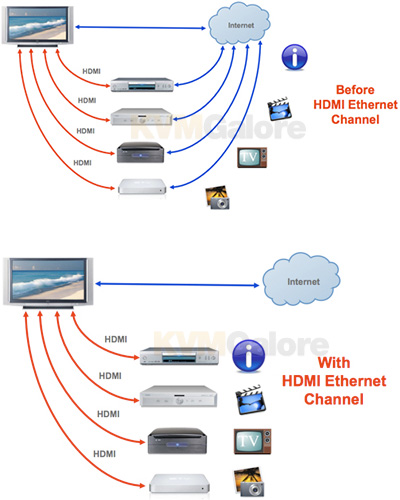 HDMI Ethernet Channel (HEC) is an HDMI 1.4 feature that allows a 100BaseT Ethernet connection over an HDMI cable. HDMI Ethernet Channel (HEC) technology consolidates video, audio, and data streams into a single HDMI cable, combining the HDMI connectivity with the power and flexibility of home entertainment networking. It incorporates a dedicated data channel into the HDMI link, enabling high-speed, bi-directional networking at up to 100 Mb/sec.
HDMI Ethernet Channel (HEC) is an HDMI 1.4 feature that allows a 100BaseT Ethernet connection over an HDMI cable. HDMI Ethernet Channel (HEC) technology consolidates video, audio, and data streams into a single HDMI cable, combining the HDMI connectivity with the power and flexibility of home entertainment networking. It incorporates a dedicated data channel into the HDMI link, enabling high-speed, bi-directional networking at up to 100 Mb/sec.
With networking capabilities now available in a wide range of IP-enabled home entertainment devices, HEC eliminates the need for a separate Ethernet connection to each networked device in a home theater system (TVs, gaming consoles, DVRs HD Display, Blu-ray player, AV receiver, media player, set-top box, etc.) from a router or switch, and simplifies wiring and system installation.
HEC support requires a new cable design, which is designated as a "High Speed HDMI Cable with Ethernet".
Back to TopA term used to describe an audio/video system designed to bring a movie theater experience into the home by the use of a large screen television and surround sound.
Back to TopThe act or process of removing and replacing an electronic peripheral or component from a device without first powering down the device.
Back to TopHyperText Markup Language (HTML) is the main markup language for creating Web pages and other information that can be displayed in a Web browser. The markup tells the Web browser how to display a Web page's words and images for the user.
HTML is written in the form of HTML elements consisting of tags enclosed in angle brackets (like <html>), within the Web page content. HTML tags most commonly come in pairs like <h1> and </h1>, although some tags represent empty elements and so are unpaired, for example <img>. The first tag in a pair is the start tag, and the second tag is the end tag (they are also called opening tags and closing tags). In between these tags Web designers can add text, further tags, comments and other types of text-based content.
The purpose of a Web browser is to read HTML documents and compose them into visible or audible Web pages. The browser does not display the HTML tags, but uses the tags to interpret the content of the page.
HTML elements form the building blocks of all websites. HTML allows images and objects to be embedded and can be used to create interactive forms. It provides a means to create structured documents by denoting structural semantics for text such as headings, paragraphs, lists, links, quotes and other items. It can embed scripts written in languages such as JavaScript which affect the behavior of HTML Web pages.
Web browsers can also refer to Cascading Style Sheets (CSS) to define the appearance and layout of text and other material. The W3C, maintainer of both the HTML and the CSS standards, encourages the use of CSS over explicit presentational HTML.
Back to TopShort for HyperText Transfer Protocol, HTTP is the underlying protocol used to transfer data over the World Wide Web. HTTP defines how messages are formatted and transmitted, and what actions Web servers and browsers should take in response to various commands.
For example, when you enter a URL in your browser, this actually sends an HTTP command to the Web server directing it to fetch and transmit the requested Web page.
This is why all Web site addresses begin with "http://".
Back to Top
 A device used to connect multiple computers or peripherals together so that they may be shared.
A device used to connect multiple computers or peripherals together so that they may be shared.
A hub is typically a boxed shaped device with several ports on it. Each device to be shared plugs into one of the ports.
Hubs are common in Ethernet, USB and FireWire applications.
Back to TopInsulation Displacement Connector. A special type of crimp connector. IDC works by piercing or pushing aside the insulator on a wire so that the connector pins can make contact with the conductor material . IDC connectors are typically pre-loaded with the pins. They are commonly used with flat ribbon cables.
Back to TopIntegrated Device Electronics. Refers to a hard drive or storage disk where the controller is integrated to the drive itself.
Back to TopInstitute for Electrical and Electronics Engineers, pronounced I-triple-E. A body of engineers, students, and scientists that develop and govern standards for the computer and electronics industry.
Back to TopA set of standards set by IEEE in 1994 to upgrade the aging parallel interface. It defined a set of protocols to enable bi-directional communication between the computer and the peripheral, improving speed and functionality.
Back to TopHigh Performance Serial Bus technology, known simply as 1394 [also known as FireWire] was developed by Apple in the 1980s. IEEE-1394 is a versatile, high-speed, and low-cost method of interconnecting personal computer peripherals and consumer electronics devices.

IEEE-1394 is similar to USB, but with a few distinct differences. First, FireWire is a peer-to-peer technology, so no host is needed: devices can connect directly together. Second, FireWire is faster with speeds up to 800Mbps (called 1394b, or FireWire800). Even when running at speeds comparable to USB (such as the common 400 Mbps mode) FireWire is able to achieve higher sustained bandwidth throughput due to more intelligent logic circuits.
Back to TopImpedance is a measure of how much a component or wire resists the flow of current through it. It is calculated by adding together the electrical properties of resistance and reactance. Because impedance affects the flow of current, it is important for a cable to maintain a constant impedance from one end to the other. Because impedance is a derivative of resistance, it is measured in Ohms.
Back to TopA type of video display where the image is drawn in an alternating pattern. The odd lines are drawn first, and then the even lines are drawn. See also, progressive. On a typical display, this alternating pattern occurs 30 times a second, so it can cause the display to flicker. Interlaced video was developed so that only half an image has to be transmitted at a time, saving bandwidth. Standard televisions are interlaced. Most computer monitors and HDTV's are non-interlaced.
Back to TopThe Internet, sometimes called simply "the Net", is a massive worldwide system of computer networks - a network of networks, a networking infrastructure. The Internet connects millions of computers together globally, forming a network in which any computer can communicate with any other computer.
Information that travels over the Internet does so using a set of protocols called TCP/IP (for Transmission Control Protocol/Internet Protocol), serving billions of users worldwide.
The Internet is used for accessing information on inter-linked documents (Web sites) of the World Wide Web (WWW), as well as for e-mail, Usenet news groups, instant messaging and FTP.
The Internet was conceived by the Advanced Research Projects Agency (ARPA) of the U.S. government in 1969 and was first known as the ARPANet. The original aim was to create a network that would allow users of a research computer at one university to be able to "talk to" research computers at other universities. A side benefit of ARPANet's design was that, because messages could be routed or rerouted in more than one direction, the network could continue to function even if parts of it were destroyed in the event of a military attack or other disaster.
The development of hypertext based technology (called World Wide Web, WWW, or just the Web) provided means of displaying text, graphics, and animations, and easy search and navigation tools that triggered Internet's explosive worldwide growth.
Today, the Internet is a public, cooperative, and self-sustaining facility accessible to billions of people worldwide. No one owns Internet, although several organizations the world over collaborate in its functioning and development. Physically, the high-speed, fiber-optic cables (called backbones) through which the bulk of the Internet data travels are owned by telephone companies in their respective countries.
The most widely used part of the Internet is the World Wide Web (often abbreviated "WWW" or called "the Web"). For many Internet users, electronic mail (e-mail) has practically replaced the Postal Service for short written transactions. Electronic mail is the most widely used application on the Net. You can also carry on live "conversations" with other computer users, using Internet Relay Chat (IRC). More recently, Internet telephony hardware and software allows real-time voice conversations over the Internet.
Back to TopInternet Protocol (IP) is the principal communications protocol used for relaying datagrams (also known as network packets) across an internetwork using the Internet Protocol Suite responsible for routing packets across network boundaries. It is the primary protocol that establishes the Internet.
IP is the primary protocol in the Internet Layer of the Internet Protocol Suite and has the task of delivering datagrams from the source host to the destination host solely based on the addresses. For this purpose, IP defines datagram structures that encapsulate the data to be delivered. It also defines addressing methods that are used to label the datagram source and destination.
Historically, IP was the connectionless datagram service in the original Transmission Control Program introduced in 1974, the other being the connection-oriented Transmission Control Protocol (TCP). The Internet Protocol Suite is therefore often referred to as TCP/IP.
Internet Protocol is responsible for addressing hosts and routing datagrams (packets) from a source host to the destination host across one or more IP networks. For this purpose the Internet Protocol defines an addressing system that has two functions: identifying hosts and providing a logical location service. This is accomplished by defining standard datagrams and a standard addressing system.
Back to TopInfrared (IR) signaling is a common method of remotely controlling consumer electronic devices. IR remote controls contain one or more infrared LED's that flash is a specific pattern, depending on the button pressed. The light beam can be detected up to 100 feet away, and decoded to operate the selected function. IR requires a direct line-of-sight between the remote control LED and the controlled device's IR receiver.
However, separate IR receivers can be located in a more convenient location to pick up the signal, and transmit it to another IR LED ("emitter", "blaster", or "flasher") that is located near the controlled device's IR receiver (or "eye"). Some devices can also store a sequence of commands for several different devices (called "macros"), and play them back from a single button press.
IR is usually a one-way communication from the remote control to the controlled device, so any feedback or confirmation usually relies on the user's ability to directly see or hear the result. This is acceptable for simple control, but creates difficulties in controlling complex systems. For this reason, more complex systems generally use either RS-232 or IP control, allowing them to confirm proper operation.
Back to TopInternet Service Provider. A company or organization that provides Internet connections to individuals or companies.
Back to TopThe outer covering of a cable. The jacket material is typically a type of PVC (Poly-vinyl Chloride). Some jackets are made with FEP (Fluorinated Ethylene Propylene) or other Teflon derivatives when a plenum-rated version of a cable is needed.
Back to TopIn cable or adapter, a jumper is a small wire or solder joint that fuses two or more conductors into one. Many times jumps are needed to fulfill the signal requirements of a particular cable's pinout.
Back to Top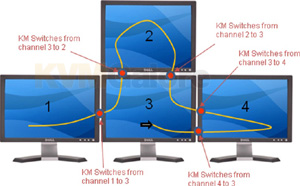 KM switch (with KM being an abbreviation for Keyboard/Mouse) is a stripped-down version of a KVM switch.
KM switch (with KM being an abbreviation for Keyboard/Mouse) is a stripped-down version of a KVM switch.
KM switch is a hardware device that allows a user to control multiple computers from a single keyboard/mouse set, while each computer is connected to its own monitor.
Switching from one computer to another typically gets accomplished via hot-key keyboard combinations or front-panel buttons.
Being that each computer is constantly displaying its video on its dedicated monitor, some KM switches feature the ability to switch from one computer to another simply by dragging the mouse-cursor across the screens. The computer that owns the screen on which the mouse-cursor is showing becomes the active computer for keyboard/mouse interaction (view available Keyboard/Mouse switch models on KVMGalore.com).
Back to Top
An all-in-one coax cable that integrates keyboard, video and mouse (KVM) connections into one cable.
Older KVM cables literally consisted of three cables - one for each connection - that were simply bonded together.
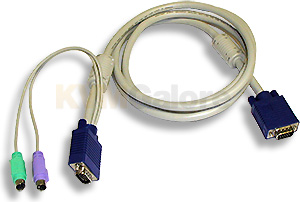
Newer KVM cables integrate the three connections into one cable (with a single jacket). Such 3-in-one cables are typically a lot thinner than older-style bonded cables, and have one main connector at the end of the cable, with one or two additional connectors coming out of the main connector as pigtails. This form of all-in-one KVM cable is expanded to also support audio connections, with pigtails for speakers and mic.
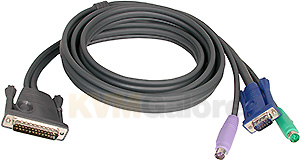
I an effort to reduce the real estate needed for KVM connections at the back of KVM switches, some KVM cables integrate the three connections into one DB-25, HD-15 or a proprietary connector, thus saving space, reducing clutter and simplifying KVM switch installations.
KVM cables are typically available at a number of fixed lengths, usually not exceeding 30 feet to avoid signal degradation (especially video-quality degradation) that is inherent to long coax cables.
Back to Top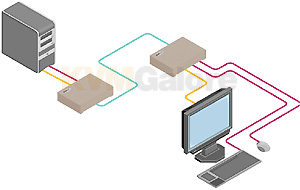 KVM (Keyboard, Video, Mouse) extender is a device used to extend a computer's console (keyboard, monitor, mouse) away from the computer.
KVM (Keyboard, Video, Mouse) extender is a device used to extend a computer's console (keyboard, monitor, mouse) away from the computer.
Instead of using long coax cables to connect the extended console to the keyboard, video and mouse ports of the computer – a KVM extender typically achieves the extension by using a CATx (CAT-5/5e/6/7) cable (or fiber-optic cable), hence supporting longer extension distances and easier installation.
Back to Top Keyboard/Video/Mouse (KVM) over IP describes a technology that supports remotely interfacing with keyboard/video/mouse signals over IP, or - in simpler terms - over a network such as Internet, WAN or LAN.
Keyboard/Video/Mouse (KVM) over IP describes a technology that supports remotely interfacing with keyboard/video/mouse signals over IP, or - in simpler terms - over a network such as Internet, WAN or LAN.
KVM over IP technology digitizes a computer's keyboard/video/mouse signals, encrypts them (for security purposes) and sends then over an IP network.
In effect, KVM over IP allows a remote user to typically use a computer (or a special KVM over IP Receiver box) connected to a network, to interface with keyboard/video/mouse port(s) of a computer (or many computers) connected to a 'KVM over IP Box' which is on the same network. This remote user interaction with the computer(s) is performed as if the user were using a console local to the computer(s).
This 'KVM over IP Box' can have a few different variations, all of which have one thing in common: Interaction with a computer (or many computers) via its keyboard, video and mouse (KVM) ports. Such variations may include:
- KVM over IP Gateway
- KVM over IP Switch
- KVM over IP Extender
- KVM over IP Matrix
- KVM over IP LCD Console
Learn more...
Back to Top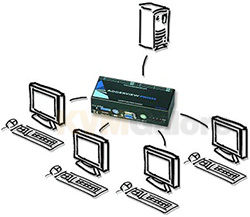 KVM (Keyboard, Video, Mouse) splitter (also known as Reverse KVM) is a computer sharing device that enables multiple users to share the use of a single computer - each from their own consoles (monitor, keyboard, and mouse).
KVM (Keyboard, Video, Mouse) splitter (also known as Reverse KVM) is a computer sharing device that enables multiple users to share the use of a single computer - each from their own consoles (monitor, keyboard, and mouse).
Being that a computer can be controlled only by one user at-a-time, the KVM splitter manages such control either automatically (on a timeout basis) or manually via a switch controlled by a user, thus allowing only one KVM console to be 'active' at any one time.
Typically, the computer's video still displays on the inactive console's screen, making a KVM splitter ideal for training environments where a second user must be shown how to perform specific tasks.
Another KVM splitter application manifests itself in a KVM extender that supports dual-access (or local-access), allowing accessing and controlling a computer from two consoles (one at-a-time), one being local (in proximity to the computer) and another extended away from the computer.
Back to Top A KVM switch (with KVM being an abbreviation for Keyboard/Video/Mouse) is a hardware device that allows a user to control multiple computers from a single console (keyboard, video monitor and mouse).
A KVM switch (with KVM being an abbreviation for Keyboard/Video/Mouse) is a hardware device that allows a user to control multiple computers from a single console (keyboard, video monitor and mouse).
Some KVM switches have also added the ability to share speakers with multiple computers (see KVMA).
Some USB KVM switches have also added the ability to share additional USB peripherals with multiple computers (See KVMP).
Some KVM switches allow more than one console to be connected to the switch, offering multi-user capability so that a few users can access and control different computers connected to the KVM switch at the same time.
Back to Top
![]() An abbreviation for Keyboard/Video/Mouse/Audio. Typically used to define a KVM switch that also supports audio, allowing many computers to be connected to (and controlled by) one set of monitor, keyboard, mouse, speakers and sometimes a microphone as well.
An abbreviation for Keyboard/Video/Mouse/Audio. Typically used to define a KVM switch that also supports audio, allowing many computers to be connected to (and controlled by) one set of monitor, keyboard, mouse, speakers and sometimes a microphone as well.
An abbreviation for Keyboard/Video/Mouse/Peripherals. Typically used to define a KVM switch that has a built-in USB hub, allowing all connected computers to share USB peripherals such as printer, camera, external hard drive, etc.
Back to TopLocal Area Network. Refers to a computer network or segment of a network that is confined to a single physical space, such as a building or group of buildings (such as a campus). Multiple LAN's can be connected together via telephone lines, radio waves, or the Internet.
Also, see WAN (Wide Area Network).
Back to Top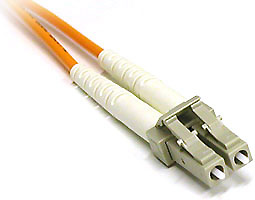
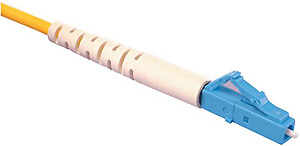 LC is a standard type of fiber optical connector termination. It's a small form factor connector that uses a 1.25mm ceramic ferrule, half the size of the SC connector.
LC is a standard type of fiber optical connector termination. It's a small form factor connector that uses a 1.25mm ceramic ferrule, half the size of the SC connector.
The connector, originally developed by Lucent (hence Lucent Connector) for telecommunications networks, provides a pull-proof design and its small size is perfect for high-density applications. It uses a retaining tab mechanism, similar to a phone or RJ45 connector, and the connector body resembles the squarish shape of SC connector. It also incorporates a unique latching mechanism that provides stability in system rack mounts.
LC connector is available in simplex or duplex versions, offers good performance, and is highly favored for singlemode applications.
Back to Top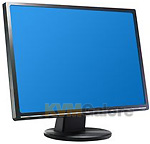 Liquid Crystal Display. A type of display that consists of a layer of liquid crystals sandwiched between two layers of glass. As an electrical current is applied to the crystals, they change their shape allowing more or less light to shine through.
Liquid Crystal Display. A type of display that consists of a layer of liquid crystals sandwiched between two layers of glass. As an electrical current is applied to the crystals, they change their shape allowing more or less light to shine through.
LCD displays are popular because they are bright, sharp, thin, and lightweight. They are most commonly used on laptop computers.
Back to Top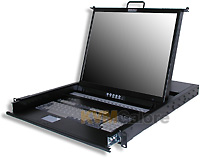 Also known as 'KVM Drawer', 'LCD Console Drawer/Tray' or 'KVM LCD Console' - LCD console is a rack-mounted all-in-one computer console with an LCD display.
Also known as 'KVM Drawer', 'LCD Console Drawer/Tray' or 'KVM LCD Console' - LCD console is a rack-mounted all-in-one computer console with an LCD display.
A thin (typically no more than 1U - 1.75" high), rugged tray/drawer constructed of metal that gets rack-mounted in an IT equipment rack so that - when not in use - it occupies minimal space in the rack. The rack-mount tray has a handle at the front, allowing the 'drawer' to slide and be pulled out for use. Once pulled out - the top portion of the sliding drawer gets lifted up on hinges, exposing a built-in LCD screen which displays the video from the connected computer. The bottom portion of the drawer consists of a built-in keyboard and a pointing device (touch-pad or track-ball), for interaction with the connected computer.
 An LCD console gets connected to the video, keyboard and mouse ports of one computer, or can have an integrated KVM switch, allowing the user to use the console to interact with many computers connected to the switch. Some models feature an integrated KVM-over-IP switch.
An LCD console gets connected to the video, keyboard and mouse ports of one computer, or can have an integrated KVM switch, allowing the user to use the console to interact with many computers connected to the switch. Some models feature an integrated KVM-over-IP switch.
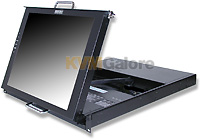 Some LCD consoles feature a sliding mechanism for the LCD screen which is separate than the sliding mechanism for the keyboard/mouse, allowing only the screen to be visible (while the keyboard/mouse tray is 'tucked in'). This feature is useful for monitoring purposes, also allowing a rack's see-through front door to be closed while the monitor is still visible.
Some LCD consoles feature a sliding mechanism for the LCD screen which is separate than the sliding mechanism for the keyboard/mouse, allowing only the screen to be visible (while the keyboard/mouse tray is 'tucked in'). This feature is useful for monitoring purposes, also allowing a rack's see-through front door to be closed while the monitor is still visible.
Light Emitting Diode. A circuit that emits light when an electrical current is applied to it.
Back to TopLow Frequency Effects. The .1 in 5.1, it is the audio channel that carries only low frequency information of 80 Hz and below (the deep bass sounds).
Back to Top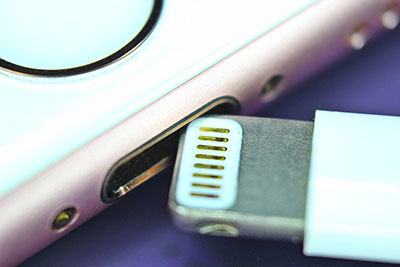 Lightning is a proprietary computer bus and power connector created by Apple Inc. It is a small connector on Apple's mobile devices like iPhones, iPads, and iPods that is used with a Lightning cable to charge and connect the devices to host computers, external monitors, cameras, USB battery chargers and other peripherals.
Lightning is a proprietary computer bus and power connector created by Apple Inc. It is a small connector on Apple's mobile devices like iPhones, iPads, and iPods that is used with a Lightning cable to charge and connect the devices to host computers, external monitors, cameras, USB battery chargers and other peripherals.
Lightning was introduced in September 2012 with the arrival of the iPhone 5 and, shortly thereafter, the iPad 4, to replace its predecessor - the 30-pin dock connector.
Using 8 pins instead of 30, the Lightning connector is 80 percent smaller than the 30-pin connector it replaced and is fully reversible, which means it doesn't matter which way the connector is facing when you plug it into the Lightning port. However, unless used with an adapter, Lightning is incompatible with cables and peripherals designed for its predecessor.
 The cable itself is small with a thin Lightning connector on one side and a standard USB Type-A connector on the other.
The cable itself is small with a thin Lightning connector on one side and a standard USB Type-A connector on the other.
The Lightning connector can also transmit audio. Starting with the iPhone 7, Apple ditched the headphone connector in its smartphone lineup and the latest iPhones include a Lightning-to-headphone adapter that connects the devices to headphones with miniplug connectors.
Back to TopBecause consumer electronics devices are using increasingly complex digital signal processing to enhance the clarity and detail of the content, synchronization of video and audio in user devices has become a greater challenge and could potentially require complex end-user adjustments.
One of the new features enabled in HDMI 1.3, Lip Sync functionality enables the automatic synchronization of video and audio signals, correcting for processor lags that can force audio and video timing out of proper alignment.
HDMI 1.3 incorporates this automatic synchronization of audio and video signals between the display and speaker outputs with total accuracy.
Back to TopLinear Pulse-Code Modulation (LPCM), also referred to as Linear PCM, is a digital audio encoding method of encoding up to 8 channels (7.1 surround) of uncompressed analog audio into a digital signal.
Back to TopThe brightness and darkness (black and white) portion of a video signal. Also called "Y".
Back to Top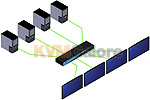 A switch that allows controlling (or viewing) multiple devices connected to its ports from multiple consoles or screens. The switch provides the user with the ability to switch between ports, routing the control (or view) of any port to any one of the controlling (or viewing) consoles.
A switch that allows controlling (or viewing) multiple devices connected to its ports from multiple consoles or screens. The switch provides the user with the ability to switch between ports, routing the control (or view) of any port to any one of the controlling (or viewing) consoles.
Matrix switches are typically used for video applications (with computers or with home-theater HDTV), allowing custom routing of multiple sources to multiple screens.
Matrix switches are also used in KVM-switching applications, in which the switch (AKA multi-user KVM switch) supports multiple users (consoles) concurrently accessing and controlling multiple computers connected to the KVM switch.
Back to TopA term typically used in reference to digital signage to describe computer software for playing back multimedia files. Most software media players support an array of media formats, including both audio and video files.
Back to Top Mobile High-Definition Link (MHL) is a proposed industry standard for a mobile audio/video interface for directly connecting mobile phones and other portable consumer electronics devices to high-definition televisions (HDTVs) and displays. The MHL standard features a single cable with a low pin-count interface able to support up to 1080p high-definition (HD) video, 192khz digital audio sound quality, and 7.1 channel surround sound, while simultaneously charging the connected device.
Mobile High-Definition Link (MHL) is a proposed industry standard for a mobile audio/video interface for directly connecting mobile phones and other portable consumer electronics devices to high-definition televisions (HDTVs) and displays. The MHL standard features a single cable with a low pin-count interface able to support up to 1080p high-definition (HD) video, 192khz digital audio sound quality, and 7.1 channel surround sound, while simultaneously charging the connected device.
MHL is being developed by the MHL Consortium, a consortium of developers of mobile devices including Nokia, Sony, Samsung, and Toshiba.
Main features include:
- The HDTV provides power to the connected device.
- Uses a single, thin cable to connect the mobile device to the HDTV.
- The HDTV remote will control the connected device with guaranteed mixed manufacturer interoperability CEC.
- 1080p uncompressed HD video.
- 7.1 surround sound uncompressed audio.
- Supports High-bandwidth Digital Content Protection (HDCP).
MHL is connection agnostic, i.e., not tied to a specific type of hardware connector.
Back to Top
 Mini DisplayPort is a miniaturized version of the DisplayPort interface. First publicly announced by Apple on October 14, 2008, it is used in revisions of the MacBook notebooks, Mac desktops and Apple Cinema Display.
Mini DisplayPort is a miniaturized version of the DisplayPort interface. First publicly announced by Apple on October 14, 2008, it is used in revisions of the MacBook notebooks, Mac desktops and Apple Cinema Display.
Mini DisplayPort is capable of driving resolutions up to 2560x1600, commonly used with 30-inch displays. With a suitable adapter, Mini DisplayPort may be used to drive displays with a VGA or DVI interface.
Back to Top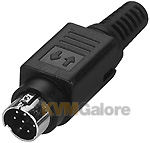 A type of DIN connector that is smaller in diameter, with the pins arranged in rows rather than in a circular manner.
A type of DIN connector that is smaller in diameter, with the pins arranged in rows rather than in a circular manner.
The most common mini-DIN connectors are the 4-pin version used for S-Video, and the 6-pin version used for PS/2-style keyboards and mice.
Also fairly-well used were the 8-pin mini-DIN connectors, used for Apple and Sun Microsystems keyboard and mouse ports, as well as for serial printer, modem, and Apple LocalTalk connections.
Back to TopModbus is a client/server data communications protocol (previously referred to as a master-slave protocol) that is based on a request-response model. Modbus has become a de facto standard communication protocol for communication between industrial electronic devices in a wide range of buses and network.
Modbus is used for transmitting information between devices that are connected to buses or networks over serial lines or Ethernet and, increasingly, using wireless.
Modbus is the most widely used network protocol in the industrial manufacturing sector. The most common use case is the communication between a human-machine interface (HMI) or supervisory control and data acquisition (SCADA) system and a sensor, programmable logic controller (PLC), or programmable automation controller (PAC). It provides a hardware-agnostic, cost-effective way to enable the interoperability of disparate automation equipment.
Modern systems require that Modbus can support the connection of multiple server devices, facilitate faster data transfers, and provide data transfers over greater distances. To do this, RS-485 and RS-422 are used. RS-485 and RS-422 (less commonly used) facilitate the use of multidrop wiring methods (connecting multiple server devices to client devices), extend the range of transmissions to up to 4000 feet before a repeater is needed, and have a data rate of 10 megabits per second (Mbps) up to 100 kilobits per second.
Examples of devices that output Modbus would be flow meters, pressure sensors, air quality sensors, power meters, etc.
A good example would be a generator that may have a Modbus RS485 output. This allows an environmental monitoring appliance to interface with the generator or power meter and pull data from it, i.e. power, voltage, frequency, runtime hours of the generator, etc.
An environmental monitoring appliance can monitor these parameters and provide alerts, graphing, and web based access to them. The environmental monitoring appliance effectively become a Modbus to SNMP TCP/IP gateway for these devices so they can be remotely monitored.
As well as monitoring, there are also Modbus set registers, so for example, based on a sensor status an environmental monitoring appliance can become a SCADA type system, where the environmental monitoring appliance can send a Modbus command to turn something on or off.
Back to Top[Also known as Molding] A method used to seal or encase a connector hood in a mold of plastic or rubber via an injection molding process. Molded hoods provide superior strain relief and an attractive appearance. Because the connector is sealed, it also prevents tampering. Most off-the-shelf PC cables are molded cables.
Back to TopMulti-Stream Transport (MST) is a DisplayPort 1.2 technology able to stream video to multiple independent displays from a single desktop or notebook DisplayPort video output.
MST can be used with daisy-chainable displays, which must have built-in MST functionality.
Daisy chaining is a term that describes the ability to connect a series of devices together using a single connection between each two devices.
DisplayPort v1.2 daisy chainable displays have both a DisplayPort input and a DisplayPort output. The DisplayPort output connects to the next downstream display. This cabling arrangement, with one DisplayPort cable between each set of monitors, provides a less cluttered system configuration.
Each of the displays, with the exception of the last display in the chain, must have DisplayPort 1.2 input and output. The last display can be an older DisplayPort 1.1 monitor (which only has a DisplayPort input).
 The operating system on the source device will see the daisy-chain devices as separate displays, and they behave as if they were connected via their own separate inputs (see image). Screen A, B, and C are each connected to each-other using a single DisplayPort cable. Screen A is then connected to the laptop or PC, which addresses the three as separate displays.
The operating system on the source device will see the daisy-chain devices as separate displays, and they behave as if they were connected via their own separate inputs (see image). Screen A, B, and C are each connected to each-other using a single DisplayPort cable. Screen A is then connected to the laptop or PC, which addresses the three as separate displays.
When configuring a daisy chained monitor setup, it is important to take into consideration two aspects.
- First, video cards usually have an inherent limitation in how many simultaneous displays they can drive; some can drive up to three displays, while others can drive four or even six.S
- Second, even though DisplayPort 1.2 offers the higher pixel rate available, there is a limitation in how many pixels can be sent down the display pipe.
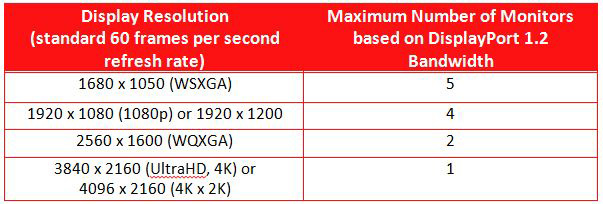
The table provides maximum monitor count vs. display resolution, based on DisplayPort 1.2 bandwidth limits.
It is not required that all of the daisy chained screens use the same resolution. For example, one 2560x1600 monitor could be used with two 1920x1080 monitors. By the same token, the monitors may also be of different sizes.
Back to Top MTRJ (Mechanical Transfer-Registered Jack) is a standard type of fiber optical connector termination. It's a duplex fiber-optic cable connector with both fibers in a single polymer ferrule.
MTRJ (Mechanical Transfer-Registered Jack) is a standard type of fiber optical connector termination. It's a duplex fiber-optic cable connector with both fibers in a single polymer ferrule.
MTRJ closely resembles an RJ-style modular plug, even getting part of its name from the resemblance. MTRJ connectors are always duplex in that they hold two fibers. The body and ferrule are normally made from plastic or plastic composite, and lock into place with a tab (just like a modular RJ-style plug).
MTRJ connector uses pins for alignment and has male and female versions. Multimode only, MTRJ connector is field terminated only by prepolished/splice method.
Based on a specification by NTT (the Japanese telecommunications company), MTRJ it was developed by AMP/Tyco and Corning and is a popular small-form-factor fiber-optic connector.
Back to Top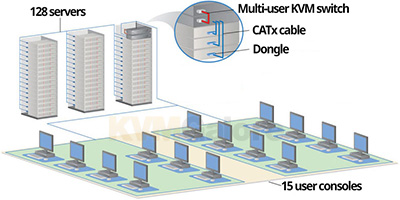
A multi-user (matrix) KVM switch allows multiple users (each using their own console) to concurrently access and use multiple computers connected to the KVM switch - one computer at a time.
A 4x24 multi-user KVM switch, for example, allows 4 users to simultaneously access and use 24 connected computers. If 2 users attempt to use the same computer at the same time - only one of them (the 1st one) will be able to control the computer, while the 2nd user typically –depending on administrator's settings - will either be denied access or will be only allowed to view the computer's video.
Back to TopA type of fiber optic mostly used for communication over short distances, such as within a building or on a campus.
Multimode fiber is optical fiber that is designed to carry multiple light rays or modes (beams) of light concurrently, each at a slightly different reflection angle within the optical fiber core.
Multimode fiber has a larger core than singlemode, large enough to propagate more than one mode of light, with the typical diameter of 62.5 micrometers or 50 micrometers. Typical multimode links have data rates of 10 Mbit/s to 10 Gbit/s over link lengths of up to 600 meters (2000 feet) - more than sufficient for the majority of premises applications.
Multimode fiber transmission is used for relatively short distances such as LANs because the modes tend to disperse over longer lengths. For longer distances, singlemode fiber is used.
Back to Top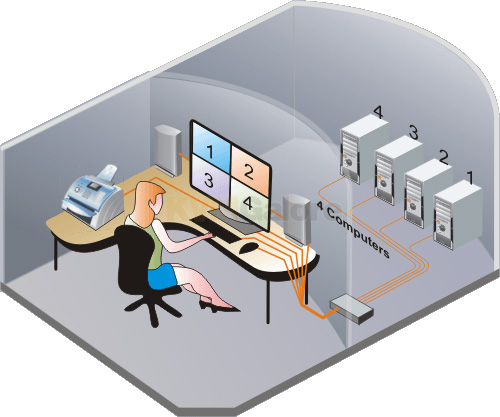 Multiviewer (AKA multiview switch or split-screen switch) is a switch that simultaneously displays video from multiple sources on one screen.
Multiviewer (AKA multiview switch or split-screen switch) is a switch that simultaneously displays video from multiple sources on one screen.
A split-screen multiview switch splits a single display into sections, individually and simultaneously displaying video from multiple sources on each section of the screen.
A 4-port multiview switch, for example, can split the screen into four sections, displaying the video of each of the 4 source on one quarter of the screen.
Multiviewers are used in applications that require real-time monitoring of multiple video feeds, where real-time multiple video sources need to be displayed on a large screen or video wall.
When the video sources are computers, a multiviewer KVM switch is used to accomplish similar split-screen video features in addition to the ability to control the attached computers using a single keyboard and mouse.
Learn more about a multiview KVM switch.
Back to Top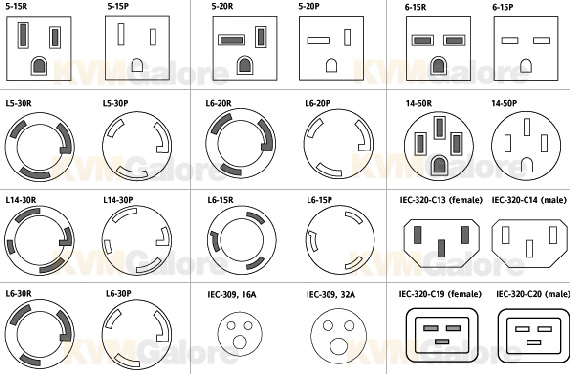 NEMA connectors are AC power plugs and receptacles used for mains electricity in North America and other countries that use the standards set by the U.S. National Electrical Manufacturers Association (NEMA).
NEMA connectors are AC power plugs and receptacles used for mains electricity in North America and other countries that use the standards set by the U.S. National Electrical Manufacturers Association (NEMA).
NEMA wiring devices are made in current ratings from 15 to 60 amperes, and electrical potential (voltage) ratings from 125 to 600 volts. Different combinations of contact blade widths, shapes, orientation, and dimensions give non-interchangeable connectors that are unique to a particular voltage, current capacity, and grounding system. NEMA 1 (two prong) and NEMA 5 (three prong) are used for commonplace domestic equipment; the others are for heavy duty or special purposes.
There are two basic classifications of NEMA device: straight-blade and locking. The straight-blade 5–15 and 5–20 are found nearly everywhere in countries using the NEMA standards, and are intended for supplying lighter-duty, general-purpose electrical devices. Twist-locking types are used for heavy industrial and commercial equipment, where increased protection against accidental disconnection is required. Numbers prefixed by L are curved-blade, twist-locking connectors; others are straight blade and non-locking.
Back to TopA system of connected computers. The purpose of a network is so the connected computers can easily share data, peripherals, or printers. The most popular type of network today is Ethernet and, of course, the Internet.
Back to TopNational Information Assurance Partnership (NIAP) is a program - officially known as the NIAP Common Criteria Evaluation and Validation Scheme for IT Security - established by the National Institute of Standards and Technology (NIST) and the National Security Agency (NSA) designed to evaluate IT product conformance to Common Criteria standard, and is responsible for U.S. implementation of the Common Criteria.
NIAP oversees evaluations of commercial IT products for use in national security systems.
The program is being implemented to help consumers select commercial off-the-shelf information technology (IT) products that meet their security requirements and to help manufacturers of those products gain acceptance in the global marketplace.
NIAP manages a national program for developing protection profiles, evaluation methodologies, and policies that will ensure achievable, repeatable, and testable requirements.
NIAP also approves Common Criteria testing laboratories to conduct these security evaluations in private sector operations across the U.S.
NIAP takes a collaborative approach to technology-specific protection profile development by supporting the creation of international technical communities of representatives from industry, government, end users, and academia. This results in consistent evaluation methodologies across U.S. testing labs and among labs associated with international Common Criteria Recognition Arrangement schemes.
NIAP also works with NATO and international standards bodies (ISO) to share Common Criteria evaluation experiences and avoid duplication of effort.
Back to TopA processing location on a network. A node can be a client, a server, or a device, such as a printer.
Back to TopA type of video display where the image is drawn in an single pass, as opposed to interlaced. Because the image is drawn in a single pass, flicker is eliminated. Standard televisions are interlaced. Most computer monitors and HDTV's are non-interlaced. See also, progressive.
Back to TopNational Television Systems Committee. Federal government agency that established the analog color television standard used in the United States. Delivers 525 lines of resolution at 60 half-frames per second.
Back to TopOLED (organic light-emitting diode) is a light-emitting diode (LED) in which the emissive electroluminescent layer is a film of organic compound (containing carbon plus some other ingredients). This layer of organic semiconductor is situated between two electrodes behind the glass screen. When electrical current is applied to the conductors, a bright light is emitted.
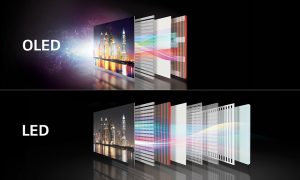 OLED technology is used to make displays and lighting.
OLED technology is used to make displays and lighting.
OLED acronym is typically used in reference to the highest-grade television sets on the market, in which each pixel in an OLED display is made of a material that glows when you jab it with electricity.
OLED panels emit their own light when an electric current is passed through, whereas cells in an LCD display require an external light source, like a giant backlight, for brightness.
Because OLEDs emit light (and do not require a backlight) they are thinner and more efficient than LCD displays (which do require a white backlight). OLED displays are not just thin and efficient - they can also be made flexible (even rollable) and transparent.
An OLED display works without a backlight; thus, it can display deep black levels and can be thinner and lighter than a liquid crystal display (LCD). In low ambient light conditions (such as a dark room), an OLED screen can achieve a higher contrast ratio than an LCD, regardless of whether the LCD uses cold cathode fluorescent lamps or an LED backlight.
A traditional LCD screen has a backlight (called a cold-cathode fluorescent light, or CCFL) which is uniform across the entire back of the screen.
An LED-LCD screen uses an array of LEDs as a backlight, which means that if a certain part of the screen is black then the LEDs behind that portion could be turned off to make it appear blacker. This is a better solution than a CCFL backlight, but it still has its problems. Since it's a light behind the LCD producing the illumination rather than the LCD layer itself, the illumination is not entirely in-sync with the pixel in front of it. The result is an effect called 'blooming', whereby LED light from bright portions of the image bleeds over into areas of blackness.
This is what separates OLEDs from LCD/LED displays. In an OLED display, the pixels themselves are the things producing the light, and so when they need to be black they are able to turn off completely, rather than relying on a backlight to turn off on their behalf.
The result is remarkably dark blacks in an image, and when you combine this with the brightness of the whites an OLED panel is able to produce you're left with a fantastically vibrant image.
In short: OLED truly is the next big thing in home entertainment and it's finally at a price where the average consumer can buy one their own. OLED televisions offer exceptional image quality (think blacker blacks and brighter whites), reduced power consumption and fast response time over traditional LED TVs, albeit at exceptionally high prices.
Back to Top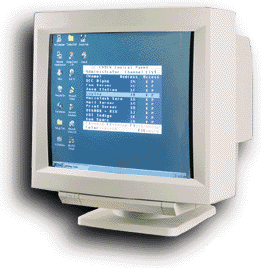 On-screen display (OSD) is a visual list of ports (or other options) that gets invoked by the user and shows up on the screen superimposed over the displayed video.
On-screen display (OSD) is a visual list of ports (or other options) that gets invoked by the user and shows up on the screen superimposed over the displayed video.
Typically used on KVM switches, OSD is invoked by hitting a specific keyboard sequence (such as tapping the 'Shift' key twice in succession).
OSD on a KVM switch typically allows the user to assign names to each port (in order to be able to identify the connected computer by name).
To switch to a certain computer – the user invokes the OSD and selects the desired computer (by name) in order to switch to it.
OSDs supporting a long list of computers (many ports on the KVM switch) may also feature sorting the list and providing the user with the ability to search for a name on the list.
Back to TopPhase Alternating Line. Television broadcast standard developed in England and Germany and used in many countries throughout Europe. Delivers 625 lines of resolution at 50 half-frames per second.
Back to TopRefers to a type of interface where the signal lines are running over multiple channels running parallel to each other. Think of parallel as a multi-lane highway for data. Common parallel interfaces are IEEE-1284, SCSI, and ATA. Parallel cables are typically thicker and larger because of the number of conductors necessary. Opposite of serial.
Back to Top Parallel ATA. Simply called ATA (or incorrectly IDE/EIDE) before SATA was introduced.
Parallel ATA. Simply called ATA (or incorrectly IDE/EIDE) before SATA was introduced.
The P was added to clearly distinguish the two technologies.
Back to Top Any cable used to patch or connect one device to another device.
Any cable used to patch or connect one device to another device.
Most common in reference to Ethernet cables.
Back to TopA device that attaches to a computer. Common peripherals are printers, keyboards, mice, etc.
Back to Top[Also known as Pinmap] The signal map of a cable. It shows how the signal conductors in the cable are arranged from one connector to the other. The pinout is what makes the signals flow correctly so the cable can work for its intended purpose. If the cable you are using does not have the correct pinout, data will not flow and your application will not work.
Back to TopPicture element. The smallest component of a video display. Pixels are the individual dots that make up the image. The number of pixels is measured by the resolution of the display. The more pixels available, the sharper the image.
Back to Top[Also known as Plasma TV or Plasma Display or Plasma Screen] A type of display that consists of a layer of plasma gas sandwiched between two layers of glass. As an electrical current is applied to the plasma it gives off energy which excites phosphors coated on the glass, producing an image. Plasma displays are bright, sharp, and thin.
Back to Top[Also known as Plenum-Rated] A type of cable jacket with fire-rated properties typically made of Teflon or Teflon derivatives. The building codes in most localities require the use of fire-rated cables when they are run through the plenum spaces of a building to prevent the spread of fire or the release of toxic gases that can result from the burning of standard PVC materials. The plenum space is typically the open space between a drop ceiling and the roof, or the open space inside walls, for which the cable gets its name.
Back to TopPower over Ethernet (PoE) describes a systems which passes electrical power along with data on Ethernet cabling with long cable lengths. This allows a single cable to provide both data connection and electrical power to devices such as wireless access points or IP cameras.
Since only two of the four pairs of the Ethernet CATx twisted-pair cable are needed for 10BASE-T or 100BASE-T, PoE power is transmitted on the unused conductors of a cable. Because twisted-pair Ethernet uses differential signaling, this does not interfere with data transmission.
Using PoE eliminates the need for a dedicated power supply for the connected device, making remote deployments easy and independent of power source. The Ethernet router or switch to which the device is connected must, of course, support PoE.
Back to TopAn electrical circuit has two sides; positive and negative. The polarity is which condition exists for a particular side. It is important to maintain polarity when connecting electrical circuits, or current will not flow. In some cases, it can damage the equipment.
Back to TopOn switches and telecommunication devices, a port (noun) is generally a specific place for being physically connected to some other device, usually with a socket and plug of some kind. On a KVM switch, for example, the number of ports determines the number of computers that get controlled through the switch. On a video splitter, for example, the number of ports determines the number of displays the original video can be duplicated onto.
Back to Top[Also known as Progressive Scanning] An HDTV resolution variant where each scan displays every line in the image raster sequentially from top to bottom (see 1080p).
Progressive scanning is considered superior to interlaced scanning for full-motion video displays, because there is less jitter, particularly for the portrayal of objects that move diagonally or vertically across the screen. The improvement is especially noticeable for fast-moving images, typical of television and DVD programs. Another advantage of progressive scanning is the fact that it is required for satisfactory video on TV sets that use micro displays, plasma displays, or liquid-crystal display (LCD) flat panels. The improved image quality afforded by full HDTV is well suited to the extra-large-screen displays used in home theater systems.
Back to TopThe language or format that is transmitted from one device to another. In order for two devices to communicate, they must be able to use the same protocol.
Back to Top
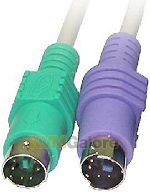 PS/2 connector is a 6-pin Mini-DIN connector used for connecting a keyboard and mouse to a PC compatible computer system. Its name comes from the IBM Personal System/2 series of personal computers, with which it was introduced in 1987.
PS/2 connector is a 6-pin Mini-DIN connector used for connecting a keyboard and mouse to a PC compatible computer system. Its name comes from the IBM Personal System/2 series of personal computers, with which it was introduced in 1987.
The PS/2 mouse connector generally replaced the older DE-9 RS-232 "serial mouse" connector, while the PS/2 keyboard connector replaced the larger 5-pin/180° DIN connector used in the IBM PC/AT design.
Original PS/2 connectors were typically black. Later the PC 97 standard introduced a color code: the keyboard port, and the plugs on compliant keyboards, were purple; mouse ports and plugs were green. Some vendors initially used a different color code, but today this code is still used on most PCs. The pinouts of the connectors are the same, but most computers will not recognize devices connected to the wrong port.
Back to Top
 A type of connector primarily used for connecting audio and video equipment. It is a single pin connector with a surrounding shield ring that was developed by the company whose name it bears.
A type of connector primarily used for connecting audio and video equipment. It is a single pin connector with a surrounding shield ring that was developed by the company whose name it bears.
Also called phono-plug, because the connector was originally develop for phonographs.
Back to TopA type of display that uses a CRT projected onto a mirror and reflected onto the back of a large screen. What most people think of when considering large screen or big screen TVs.
Back to Top A component or an audio system that consists of an amplifier, pre-amplifier, signal processor, tuner, and junction point for the other components.
A component or an audio system that consists of an amplifier, pre-amplifier, signal processor, tuner, and junction point for the other components.
The receiver is the heart of any audio/video or home theater system.
Back to TopThe number of times a display can paint its screen with a complete image, or the frequency with which a video image is refreshed, expressed as either frames per second (i.e. 60 fps) or as an equivalent frequency (i.e. 60Hz). Faster refresh rates tend to render smoother motion sequences.
With computers, the refresh rate for each display depends on the video card used. You can change the refresh rate in the display properties. However, if you change the refresh rate to a setting that the display or video card cannot support, the display goes blank or the image becomes distorted. It is recommended to consult the display and video card specifications (before changing the settings) to determine the supported refresh rates.
For computer use, an older refresh rate standard, developed by the Video Electronics Standards Association (VESA), was only 60Hz. This refresh rate caused the display's image to flicker, causing eye fatigue and headaches in users. A newer standard set the refresh rate to 75Hz. It is believed that 70Hz or higher eliminates the flicker.
Refresh rates for broadcast TV vary by region. For example, European HD systems run at 50Hz.
Back to TopA device that boosts the original signal transmitted over a long copper cable.
For digital signals, this usually means cleaning up timing and delay issues (re-clocking) that have degraded, in addition to signal amplification.
Back to TopThe measure of the amount of opposition of a body or substance to the electrical current passing through it. The more resistance you have in a cable, the less current flows through the cable.
Back to Top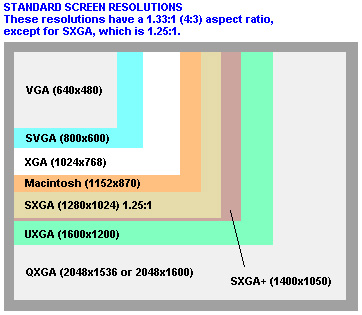 The measure of the number of pixels a display can produce. It is shown as the number of pixels (horizontal) by the number of lines (vertical).
The measure of the number of pixels a display can produce. It is shown as the number of pixels (horizontal) by the number of lines (vertical).
A screen resolution of 1920x1200 means 1,920 pixels horizontally across each of 1,200 lines, which run vertically from top to bottom. Occasionally, a third number is added to the specification to designate the refresh rate; for example, 1280x1024 @ 60Hz means 1280x1024 pixels at 60Hz (refreshed 60 times per second).
The higher the resolution, the more information (pixels) can be displayed on screen at one time.
Back to Top
The mechanical anchor mechanism used to secure two connectors together. Typical retention methods are thumbscrews, squeeze latches, or friction fit.
Back to TopRadio Frequency Interference – A special type of EMI (electromagnetic interference) that is specific to transmitted fields within the radio frequency band, typically over 1Mhz. Whereas EMI is a by-product of electrical devices, RFI is typically a deliberate signal transmission such as a radio station, TV, cordless phone, etc. Because RFI is a type of EMI, is can be just as detrimental to the signals in a wire and may need to be shielded against.
Back to Top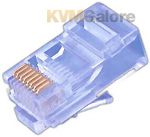 RJ45 is a registered jack standard for a modular connector using 8 conductors, which specifies the physical male and female connectors as well as the pin assignments of the wires. The "RJ45" physical connector is standardized as the IEC 60603-7 8P8C modular connector with different "categories" of performance, commonly known as RJ45.
RJ45 is a registered jack standard for a modular connector using 8 conductors, which specifies the physical male and female connectors as well as the pin assignments of the wires. The "RJ45" physical connector is standardized as the IEC 60603-7 8P8C modular connector with different "categories" of performance, commonly known as RJ45.
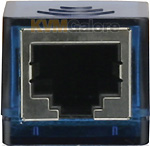 The 8P8C modular connector - commonly referred to as an RJ45 in the context of Ethernet and Category 5 cables - is a modular connector commonly used to terminate twisted pair and multiconductor flat cable. These connectors are commonly used for Ethernet over twisted pair and other applications involving unshielded twisted pair, shielded twisted pair, and multiconductor flat cable.
The 8P8C modular connector - commonly referred to as an RJ45 in the context of Ethernet and Category 5 cables - is a modular connector commonly used to terminate twisted pair and multiconductor flat cable. These connectors are commonly used for Ethernet over twisted pair and other applications involving unshielded twisted pair, shielded twisted pair, and multiconductor flat cable.
Electronics catalogs commonly advertise 8P8C modular connectors as "RJ45", but of course an installer can wire the jack to any pin-out or use it as part of a generic structured cabling system using RJ45 patch panels for both phone and data. Virtually all electronic equipment which uses an 8P8C connector will document it as an "RJ45" connector.
Back to Top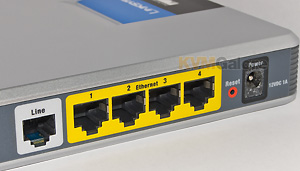 A router is a special type of Ethernet switch that provides a superior level of packet routing. A router perform the "traffic directing" functions on the Internet.
A router is a special type of Ethernet switch that provides a superior level of packet routing. A router perform the "traffic directing" functions on the Internet.
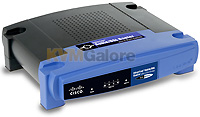 The most familiar type of routers are home and small office routers that simply pass data, such as web pages and email, between the home computers and the owner's cable or DSL modem, which connects to the Internet (ISP).
The most familiar type of routers are home and small office routers that simply pass data, such as web pages and email, between the home computers and the owner's cable or DSL modem, which connects to the Internet (ISP).
More sophisticated routers, however, range from enterprise routers, which connect large business or ISP networks up to the powerful core routers that forward data at high speed along the optical fiber lines of the Internet backbone.
Back to Top[Also known as RS232] - Recommended Standard 232. This is the de facto standard for communication through PC serial ports. It can refer to cables and ports that support the RS-232 standard.
Back to Top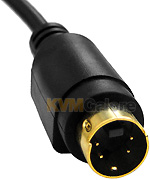
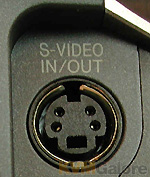 The "middle of the road" video signal, found on many older consumer grade video hardware. S-Video separates the picture into two separate components, Chrominance and Luminance. This lets the video signal bypass the comb filter, which helps maintain signal integrity.
The "middle of the road" video signal, found on many older consumer grade video hardware. S-Video separates the picture into two separate components, Chrominance and Luminance. This lets the video signal bypass the comb filter, which helps maintain signal integrity.
S-video typically uses a 4-pin mini-DIN connector. Also known as S-VHS, or Super VHS, it was developed in the 80s by JVC as a response to attempts by Sony to corner the VCR market with their Beta technology.
Back to Top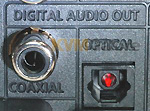
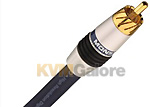 Stands for Sony/Philips Digital Interconnect Format, the two companies being the primary designers of the S/PDIF format.
Stands for Sony/Philips Digital Interconnect Format, the two companies being the primary designers of the S/PDIF format.
S/PDIF specifies a Data Link Layer protocol and choice of Physical Layer specifications for carrying digital audio signals between devices and stereo components.
A common use for the S/PDIF interface is to carry compressed digital audio, used to connect the output of a DVD player to a home theater receiver that supports Dolby Digital or DTS surround sound. Another common use is to carry uncompressed digital audio from a CD player to a receiver.
Back to Top Serial ATA, or Serial Advanced Technology Attachment. SATA is the latest evolution of the aging ATA storage technology interface.
Serial ATA, or Serial Advanced Technology Attachment. SATA is the latest evolution of the aging ATA storage technology interface.
SATA advantages are speed (up to 150 MB/s currently), smaller and thinner cables and connectors, and lower power requirements.
Opposite of PATA.
Back to Top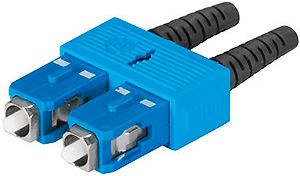 SC (Standard Connector; Subscriber Connector) is a standard type of fiber optical connector termination. It's a fiber-optic cable connector with a 2.5mm pre-radiused zirconia ferrule that uses a push-pull latching mechanism similar to common audio and video cables.
SC (Standard Connector; Subscriber Connector) is a standard type of fiber optical connector termination. It's a fiber-optic cable connector with a 2.5mm pre-radiused zirconia ferrule that uses a push-pull latching mechanism similar to common audio and video cables.
The connector, originally developed in Japan by NTT (the Japanese telecommunications company), provides a push-on/pull-off mating mechanism which is generally easier to use than the twist-style ST connector when in tight spaces. The SC connector body is square shaped, and two SC connectors can be held together with a plastic clip.
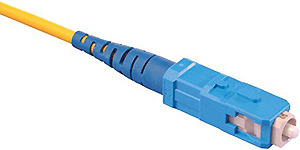 Available in simplex and duplex styles, SC snap-in connectors are widely used for their excellent performance, as they latch with a simple push-pull motion, providing quick patching of cables into rack or wall mounts.
Available in simplex and duplex styles, SC snap-in connectors are widely used for their excellent performance, as they latch with a simple push-pull motion, providing quick patching of cables into rack or wall mounts.
Scalers are add-on devices placed between the source and the display that enable the conversion of an input video signal from one format to a different resolution. Today more and more people want to use their main digital, high definition display with a variety of video sources, such as computers, DVD players, set-top boxes, gaming consoles and more. At their most basic level, home-theater scalers will accept any of these sources and properly convert them for pixel format compatibility with your main display.
Incoming video signals from different video sources (composite, component, HDMI) are converted to user-selectable output resolutions supporting any type of display, projector and monitor in all high definition resolutions up to 1920x1200 or 1080p.
Scalers can improve the quality of the image if the display has an inexpensive built-in scaler. This is done by outputting the video set to the native resolution of the display, bypassing its internal scaler. This ensures the best quality video possible.
Back to TopSmall Computer System Interface. Pronounced "skuzzy". A set of standards designed for the connection of peripheral devices to computers. SCSI was ratified in 1986 (earlier versions date back to 1979) and has evolved much over the subsequent years to keep up with demands of speed and reliability. SCSI is a parallel bus interface that requires termination. The evolution over the years has created a large array of connectivity options for SCSI, and makes it one of the most confusing technologies to implement.
Back to TopSerial Digital Interface. A serial link standardized by ITU-R BT.656 and the Society of Motion Picture and Television Engineers (SMPTE). SDI transmits uncompressed digital video over 75-ohm coaxial cable within studios, and is seen on most professional video infrastructure equipment.
The first revision of the standard, SMPTE 259M, was defined to carry digital representation of analog video such as NTSC and PAL over a serial interface and is more popularly known as standard-definition SD-SDI. The data rate required to transmit SD SDI is 270 Mbps.
With the advent of high-definition (HD) video standards such as 1080i and 720p, the interface was scaled to handle higher data rates of 1.485 Gbps. The 1.485-Gbps serial interface is commonly called the HD-SDI interface and is defined by SMPTE 292M, using the same 75-ohm coaxial cable. Studios and other video production facilities have invested heavily on the hardware infrastructure for coaxial cable and have a vested interest in extending the life of their infrastructure.
Fortunately, SMPTE has ratified a new standard called SMPTE 424M that doubles the SDI data rates to 2.97 Gbps using the same 75-ohm coaxial cable. This new standard, also called 3-Gbps or 3G-SDI, enables higher resolution of picture quality required for 1080p and digital cinema.
Back to TopRefers to a type of interface where the signal lines are run over a single channel one bit at a time. Think of serial as a single-lane highway for data. Common serial interfaces are RS232, USB, and SATA. Serial cables are typically thinner and smaller because of the few number of conductors necessary. Opposite of parallel.
Back to TopA computer or device on a network that manages applications or resources. Servers are powerful computers often dedicated to a singular task. Types of servers are: File servers – used to store, retrieve, and archive files; Print servers - manage one or more printers; Network servers - manage network traffic; and database or application servers – process one or more applications or programs. See Client/Server.
Back to Top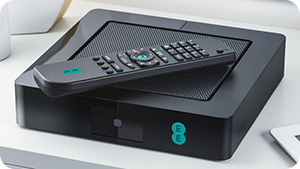 A Set-top box is a generic term for a video receiver, such as a cable or satellite receiver, that was originally intended to sit on top of and connect to a TV set (although today's flat-screen TV's make this a misnomer).
A Set-top box is a generic term for a video receiver, such as a cable or satellite receiver, that was originally intended to sit on top of and connect to a TV set (although today's flat-screen TV's make this a misnomer).
Set-top boxes convert proprietary digital video signals into conventional video (often high-definition) and audio.
Since the set-top box tuner replaces the TV set's built-in tuner, it often requires a separate remote control.
Back to TopSFP (small form-factor pluggable) is a compact, hot-pluggable network interface module format used for both telecommunication and data communications applications.
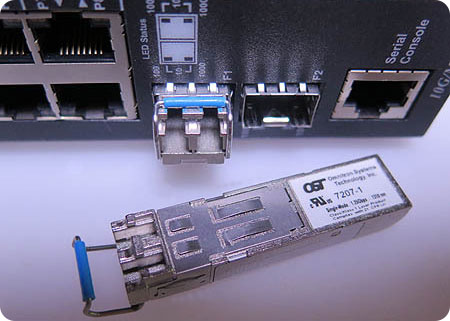
An SFP interface on networking hardware is a modular port/slot for a media-specific transceiver, such as for a fiber-optic cable or a copper cable. An SFP module is simply a small modular transceiver that plugs into an SFP port. An SFP module is hot-pluggable, which makes it easy to adjust existing networks without having to redesign the entire cable infrastructure.
The advantage of using SFPs compared to fixed interfaces (e.g. modular connectors in Ethernet switches) is that individual ports can be equipped with different types of transceiver as required.
SFP modules come in various types on the basis of different classification standards. They work with copper or fiber optics.
On the fiber optics side, there are single-mode SFP modules and multi-mode SFP modules, which allow users to select the appropriate transceiver according to the required optical range for the network.
At introduction, typical speeds were 1 Gbit/s for Ethernet SFPs and up to 4 Gbit/s for fiber SFP modules. In 2006, SFP+ specification brought speeds up to 10 Gbit/s.
Back to TopUsed in a cable to provide a protective layer of the signal conductors from EMI (Electro-Magnetic Interference) and RFI (Radio Frequency Interference). The shield works by providing a low-resistance path that collects the stray interference signals and grounds them to earth so that they do not get into the signal wires. There are two types of shields used in cables; a foil shield, and a braided shield. When both are used in a cable, it is called a double-shield, or foil and braid.
Back to TopA type of fiber optic that is designed for the transmission of a single ray or mode of light as a carrier and is used for long-distance signal transmission. For short distances, multimode fiber is used.
With a core diameter of less than 10 microns, singlemode fiber has a much smaller core than multimode fiber. Used for high-speed transmission over long distances, singlemode provides greater bandwidth than multimode, but its smaller core makes it more difficult to couple the light source.
Singlemmode fiber is designed for high-bandwidth connections over long distances. It is commonly available in both 8/125µ and 9/125µ types. Singlemode fiber supports longer cables than multimode fiber, but is generally more expensive, as it requires a more precise laser optical source.
Singlemmode can use LC, SC, ST, MTRJ, and other connectors. Some devices designed for singlemode fiber can also support multimode fiber, but over shorter distances.
Back to TopSimple Mail Transfer Protocol (SMTP) is an Internet standard for electronic mail (e-mail) transmission across Internet Protocol (IP) networks.
While electronic mail servers and other mail transfer agents use SMTP to send and receive mail messages, user-level client mail applications typically use SMTP only for sending messages to a mail server for relaying. For receiving messages, client applications usually use either the Post Office Protocol (POP) or the Internet Message Access Protocol (IMAP) or a proprietary system (such as Microsoft Exchange or Lotus Notes/Domino) to access their mail box accounts on a mail server.
SMTP uses TCP port 25. The protocol for new submissions (MSA) is effectively the same as SMTP, but it uses port 587 instead. SMTP connections secured by SSL are known by the shorthand SMTPS, though SMTPS is not a protocol in its own right.
Back to TopSimple Network Management Protocol [SNMP] is an Internet standard application-layer protocol used for collecting and organizing information about managed devices and their functions.
SNMP provides a common language for network devices to relay management information within single- and multivendor environments in a local area network (LAN) or wide area network (WAN).
SNMP is widely used in network management for network monitoring. Devices that typically support SNMP include cable modems, routers, switches, servers, workstations, printers, environmental monitors, UPSs and more.
SNMP exposes management data in the form of variables on the managed systems organized in a management information base (MIB) which describe the system status and configuration. These variables can then be remotely queried (and, in some circumstances, manipulated) by managing applications.
The most recent iteration of SNMP, version 3, includes security enhancements that authenticate and encrypt SNMP messages as well as protect packets during transit.
Back to Top A device that takes one signal (from one source) and broadcasts (splits) it to many destinations at the same time – each destination receiving the same signal.
A device that takes one signal (from one source) and broadcasts (splits) it to many destinations at the same time – each destination receiving the same signal.
Splitters are typically used in video and audio/video distribution applications such as digital signage, or for distribution of HDTV to multiple screens. An A/V splitter is sometimes referred to as a distribution amplifier (DA).
Splitters may support the target destinations being in proximity to the source, or being far away from the source, typically using CAT-5 cable as means of connecting the source to the destination.
Back to TopSecure Shell (SSH), sometimes known as Secure Socket Shell, is a UNIX-based command interface and network protocol for securely getting access to a remote computer.
It is widely used by network administrators for secure data communication, remote command-line login, remote command execution, and other secure network services between two networked computers that connect - via a secure channel over an insecure network - a server and a client (running SSH server and SSH client programs, respectively), most commonly to control Web and other kinds of servers remotely.
SSH commands are encrypted and secure in several ways. Both ends of the client/server connection are authenticated using a digital certificate, and passwords are protected by being encrypted.
The best-known application of the protocol is for access to shell accounts on Unix-like operating systems, but it can also be used in a similar fashion for accounts on Windows.
SSH was designed as a replacement for Telnet and other insecure remote shell protocols. The encryption used by SSH is intended to provide confidentiality and integrity of data over an unsecured network, such as the Internet.
Back to Top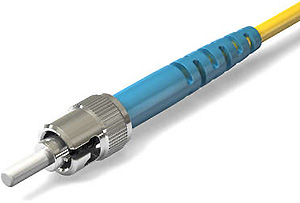 ST (Straight Tip) is a standard type of fiber optical connector termination. It's a fiber-optic cable connector that uses a bayonet plug and socket.
ST (Straight Tip) is a standard type of fiber optical connector termination. It's a fiber-optic cable connector that uses a bayonet plug and socket.
ST connector uses a half-twist bayonet type of lock to keep the connection secure. It uses a 2.5mm ferrule with a round plastic or metal body. The connector stays in place with a "twist-on/twist-off" bayonet-style mechanism. And because STs are spring-loaded, you have to make sure they are seated properly.
Available in singlemode and multimode, ST connector features reliable and durable field installation, with a design that enables installers to crimp the back of the body directly onto the cable jacket.
Originally developed by AT&T, ST was the first de facto standard connector for most commercial wiring. It was one of the first connector types widely implemented in fiber optic networking applications, and is probably still the most popular connector for multi-mode networks, like most buildings and campuses.
Although extremely popular for many years, ST connector is slowly being supplanted by smaller, denser connections in many installations.
Back to Top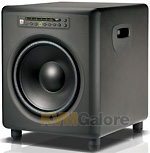 A special form of speaker used to reproduce only the lower portion of the audible frequency spectrum usually from 80 Hz down to or below 20 Hz.
A special form of speaker used to reproduce only the lower portion of the audible frequency spectrum usually from 80 Hz down to or below 20 Hz.
See LFE.
Back to Top Literally, surrounded by sound. A speaker setup that puts the listener in the center of a series of speakers so that sounds can be heard from any direction. Popular with home theater setups and cinemas.
Literally, surrounded by sound. A speaker setup that puts the listener in the center of a series of speakers so that sounds can be heard from any direction. Popular with home theater setups and cinemas.
A device that allows controlling (or viewing) multiple devices connected to its ports from one console or screen. The switch provides the user with the ability to switch from one port to another, thus controlling (or viewing) the device connected to that port, typically one port at a time.
 Most common switches may include:
Most common switches may include:
- HDTV Switch – Connects multiple sources (DVD player, set-top box, etc.) to be viewed on one HDTV screen.
- KVM Switch – Connects multiple computers to be controlled by one console (monitor, keyboard and mouse).
- Serial-Console Switch – Connects multiple (networking) serial devices (routers, Ethernet Switches, etc.) to be controlled by one ("dumb") terminal.
- Video Switch – Connects multiple video sources (computers or home-theater devices) to be displayed on one display.
Back to Top
TCP/IP (Transmission Control Protocol/Internet Protocol) is the basic communication language or protocol of the Internet. It can also be used as a communications protocol in a private network (either an intranet or an extranet). When you are set up with direct access to the Internet, your computer is provided with a copy of the TCP/IP program just as every other computer that you may send messages to or get information from also has a copy of TCP/IP.
TCP/IP is a two-layer program. The higher layer, Transmission Control Protocol, manages the assembling of a message or file into smaller packets that are transmitted over the Internet and received by a TCP layer that reassembles the packets into the original message. The lower layer, Internet Protocol, handles the address part of each packet so that it gets to the right destination. Each gateway computer on the network checks this address to see where to forward the message. Even though some packets from the same message are routed differently than others, they'll be reassembled at the destination.
TCP/IP uses the client/server model of communication in which a computer user (a client) requests and is provided a service (such as sending a Web page) by another computer (a server) in the network. TCP/IP communication is primarily point-to-point, meaning each communication is from one point (or host computer) in the network to another point or host computer.
Many Internet users are familiar with the even higher layer application protocols that use TCP/IP to get to the Internet. These include the World Wide Web's Hypertext Transfer Protocol (HTTP), the File Transfer Protocol (FTP), Telnet (Telnet) which lets you logon to remote computers, and the Simple Mail Transfer Protocol (SMTP). These and other protocols are often packaged together with TCP/IP as a "suite".
Back to TopTelnet is a network protocol used on the Internet or local area networks (LANs) to provide a bidirectional interactive text-oriented communication facility using a virtual terminal connection.
Through Telnet, an administrator or another user can access someone else's computer remotely.
On the Web, HTTP and FTP protocols allow you to request specific files from remote computers, but not to actually be logged on as a user of that computer. With Telnet, you log on as a regular user with whatever privileges you may have been granted to the specific application and data on that computer.
Most network equipment and operating systems with a TCP/IP stack support a Telnet service for remote configuration. However, because of serious security issues when using Telnet over an open network such as the Internet, its use for this purpose has waned significantly in favor of SSH.
Back to TopTo end; to terminate a wire means to put a connector or connector pin on it. You are putting an end to the cable. In SCSI applications, it means you are putting an end to the SCSI chain by the use of a terminator.
Back to TopA terminator is device used to end a signal chain, typically used for SCSI and older type of Ethernet such as 10-Base2. The terminator brings an abrupt end to the electrical signals moving down the cable. Without the terminator, the signals would hit the end of the cable and bounce back, causing interference and data corruption. Also, a cybernetic organism played by Arnold Schwarzenegger.
Back to Top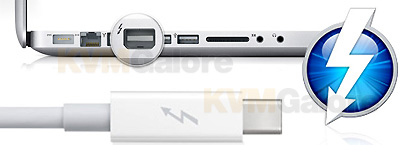 Thunderbolt is an input/output (I/O) interface for connecting peripheral devices to a computer, supporting high-resolution displays and high-performance data devices through a single, compact port.
Thunderbolt is an input/output (I/O) interface for connecting peripheral devices to a computer, supporting high-resolution displays and high-performance data devices through a single, compact port.
Thunderbolt combines PCI Express and DisplayPort into a serial data interface that can be carried over a single cable.
With PCI Express technology, you can use existing USB and FireWire peripherals - even connect to Gigabit Ethernet and Fiber Channel networks - using simple adapters.
Thunderbolt uses a Mini DisplayPort connector and DisplayPort 1.1a protocol, supporting a top speed of 10 Gbps*.
 Because Thunderbolt I/O is based on DisplayPort technology, any Mini DisplayPort display plugs right into the Thunderbolt port. Thunderbolt also supports DisplayPort, DVI, HDMI, and VGA displays through the use of adapters.
Because Thunderbolt I/O is based on DisplayPort technology, any Mini DisplayPort display plugs right into the Thunderbolt port. Thunderbolt also supports DisplayPort, DVI, HDMI, and VGA displays through the use of adapters.
Thunderbolt was developed by Intel and brought to market with technical collaboration from Apple. It was introduced commercially on Apple's updated MacBook Pro lineup in February 2011, using the same connector as Mini DisplayPort.
* Thunderbolt features two data channels, each supporting 10 Gbps, hence a total 20 Gbps is achievable.
Back to Top Thunderbolt 2 replaces the original Thunderbolt as an input/output (I/O) interface for connecting peripheral devices to a computer, supporting high-resolution displays and high-performance data devices through a single, compact port.
Thunderbolt 2 replaces the original Thunderbolt as an input/output (I/O) interface for connecting peripheral devices to a computer, supporting high-resolution displays and high-performance data devices through a single, compact port.
Thunderbolt 2 was developed by Intel and brought to market with technical collaboration from Apple at the end of 2013.
Thunderbolt 2 uses a Mini DisplayPort connector and DisplayPort 1.2 protocol, supporting a top speed of 20 Gbps.
Thunderbolt 2 supports video streaming to a single 4K monitor, or to dual 1080p monitors, and is able to transfer a 4K video while simultaneously displaying it on a discrete monitor.
 Because Thunderbolt I/O is based on DisplayPort technology, any Mini DisplayPort display plugs right into the Thunderbolt 2 port. Thunderbolt 2 also supports DisplayPort, DVI, HDMI, and VGA displays through the use of existing adapters.
Because Thunderbolt I/O is based on DisplayPort technology, any Mini DisplayPort display plugs right into the Thunderbolt 2 port. Thunderbolt 2 also supports DisplayPort, DVI, HDMI, and VGA displays through the use of existing adapters.
Thunderbolt 2 is backwards compatible, which means that all Thunderbolt 2 cables and connectors are compatible with the original Thunderbolt.
Back to TopThunderbolt 3 replaces Thunderbolt 2 as an input/output (I/O) interface for connecting peripheral devices to a computer, supporting high-resolution displays and high-performance data devices through a single, compact port.
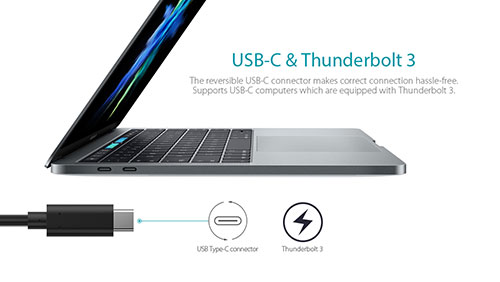 Thunderbolt 3 was developed by Intel and brought to market with technical collaboration from Apple at the end of 2015.
Thunderbolt 3 was developed by Intel and brought to market with technical collaboration from Apple at the end of 2015.
Unlike previous versions, Thunderbolt 3 uses a USB Type-C connector and DisplayPort 1.2, HDMI 2.0 and USB 3.1 Gen-2 protocols, supporting a top speed of 40 Gbps.
Compared to Thunderbolt 2, Thunderbolt 3 doubles the bandwidth to 40 Gbps, halves power consumption, and simultaneously drives two external 4K displays at 60Hz (or a single external 4K display at 120Hz, or a 5K display at 60Hz when using Apple's implementation for the late-2016 MacBook Pros) instead of just the single display Thunderbolt 2 can drive.
With its use of a compatible USB Type-C connector, Thunderbolt 3 also supports Thunderbolt 2, USB Type-A, USB Type-B, Lightening, DisplayPort, DVI, HDMI, and VGA connections through the use of adapters.
In January 2018, Intel announced a product refresh which enhanced robustness and added support for DisplayPort 1.4.
Back to TopThunderbolt 4 offers subtle enhancements over Thunderbolt 3.
Thunderbolt 4 and Thunderbolt 3 similarities
• Use the USB Type-C physical connector
• Maximum throughput of 40Gbps
• At least 15 watts and up to 100 watts of charging power
• Support for 10Gbps networking
Thunderbolt 4 enhancements over Thunderbolt 3
• Support for two 4K displays, or to one 8K display (some, but not all Thunderbolt 3 computers supported this as well)
• Support 32Gbp data rate via PCI Express (vs. 16Gbps for Thunderbolt 3)
• Wake a computer up from sleep by a connected keyboard or mouse
• Thunderbolt 4 cables support 40Gbps throughput at up to two meters (6.5 feet) in length (up from the 0.5-meter maximum of a passive Thunderbolt 3 cable)
• Support for docks with up to four Thunderbolt 4 ports
Double the PCI Express data rate will certainly be put to good use by anyone who regularly transfers gigantic files of high-resolution video and other large data sets from storage drives to their PC for editing.
Unlike Thunderbolt 3, the ability to wake a computer with the shake of a mouse or the tap of a keyboard is now standard on Thunderbolt 4.
Thunderbolt 4 also works harder to keep your data safe by requiring Intel VT-d-based direct memory access (DMA) protection.
Thunderbolt 4 is fully compatible with prior generations of Thunderbolt and USB peripherals.
Back to Top
Set of specifications and certifications designed by Lucasfilm to ensure optimum reproduction of movie sound and video in movie theaters and home theaters. Stands for Tomlinson Holman eXperience. Tom Holman was a Lucasfilm sound engineer.
Back to TopThe shape or design abstract of a LAN or connected system. Three principle topologies are used; bus topology – all nodes are connected in a linear fashion to a single bus or backbone (also called a daisy-chain) ; star topology – all nodes are connected to a central point, typically a hub; and ring topology – all nodes are connected together in a closed loop.
Back to Top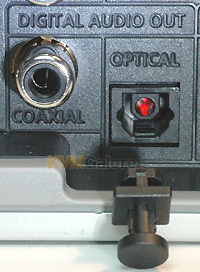
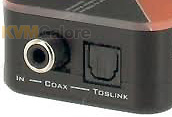
 Stands for "Toshiba Link", and is Toshiba's brand name for optical digital audio cables. TOSLink is the most common type of digital optical connector.
Stands for "Toshiba Link", and is Toshiba's brand name for optical digital audio cables. TOSLink is the most common type of digital optical connector.
TOSLink comes in two types; a square shaped plug used on home theater equipment, and a mini-plug (similar to a headphone plug) used on handheld digital devices like mini-disc players.
Back to Top TRRS connector is a four-contact version of an audio connector (or phone connector), where T stands for "tip", R stands for "ring", and S stands for "sleeve".
TRRS connector is a four-contact version of an audio connector (or phone connector), where T stands for "tip", R stands for "ring", and S stands for "sleeve".
A TRRS connector is cylindrical in shape, and is typically used in compact camcorders and portable media players, sometimes also in laptop computers and smartphones, providing stereo sound plus a video signal.
Proprietary interfaces using four-conductor TRRS connectors also exist, where the extra conductor is used to supply power for accessories. A four-conductor 3.5 mm plug is also used as a speaker-microphone connector on handheld amateur radio transceivers and on mobile phones.
This type connector was invented for use in telephone switchboards in the 19th century, AKA phone connector. In its original configuration, the outside diameter of the "sleeve" conductor was ¼ inch. The 3.5 mm (approx. ⅛ inch) version is also known as the miniature (or mini) version of a phone connector.
See: TS connector; TRS connector
Back to Top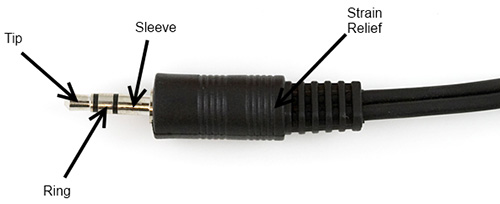 TRS connector is a three-contact version of an audio connector (or phone connector), where T stands for "tip", R stands for "ring", and S stands for "sleeve".
TRS connector is a three-contact version of an audio connector (or phone connector), where T stands for "tip", R stands for "ring", and S stands for "sleeve".
A TRS connector is cylindrical in shape, and is typically used in audio applications with MP3 music players, iPods and smartphones to carry stereo sound.
This type connector was invented for use in telephone switchboards in the 19th century, AKA phone connector. In its original configuration, the outside diameter of the "sleeve" conductor was ¼ inch. The 3.5 mm (approx. ⅛ inch) version is also known as the miniature (or mini) version of a TRS phone connector.
 The most immediately recognizable 3.5 mm (⅛") TRS connector is the version often seen as the plug on the end of a pair of headphones.
The most immediately recognizable 3.5 mm (⅛") TRS connector is the version often seen as the plug on the end of a pair of headphones.
The 3.5 mm TRS audio connector, which is the most commonly used in portable application today, has been around at least since the Sony EFM-117J radio which was released in 1964. It became very popular with its application on the Walkman in 1979.
See: TS connector; TRRS connector
Back to Top TS connector is a two-contact version of an audio connector (or phone connector), where T stands for "tip", and S stands for "sleeve".
TS connector is a two-contact version of an audio connector (or phone connector), where T stands for "tip", and S stands for "sleeve".
A TS connector is cylindrical in shape, and is typically used in audio applications to carry mono sound.
This type connector was invented for use in telephone switchboards in the 19th century and is still widely used. Specific models are termed mini jack, headphone jack and microphone jack, or are referred to by size, i.e. 3.5 mm or 6.35 mm.
In its original configuration, the outside diameter of the "sleeve" conductor was ¼ inch (exactly 6.35 mm). The "mini" connector has a diameter of 3.5 mm (approx. ⅛ inch) and the "sub-mini" connector has a diameter of 2.5 mm (approx. 3⁄32 inch).
See: TRS connector; TRRS connector
Back to TopAn electronic device used to receive coded signal transmissions and decode them into audio and video information.
Back to TopTwo conductors twisted together. The purpose of twisted pair is to help reduce EMI/RFI interference by utilizing a principle called differential or balanced signaling. If the transmitting device does not utilize either of those methods, there is no technical advantage to using a twisted pair cable. CAT-5 cable, used for Ethernet, is the most famous type of twisted pair cable used today.
Back to Top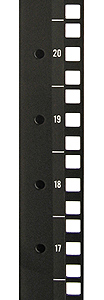
"U", or less commonly known as Rack Unit, or "RU", is a unit of measure used to describe the height of equipment intended for mounting in a 19-inch rack or a 23-inch rack (the dimension refers to the width of the equipment mounting frame in the rack). One rack unit ("U") is 1.75 inches (44.45 mm) high.
The height of a piece of rack mounted equipment is frequently described as a number in "U". For example, equipment which is 1¾" high is referred to as 'one rack unit' or "1U"; 3½" high is referred to as 2 rack units or "2U" and so on.
Each U on a rack's mounting rail consists of three (3) holes. The hole spacing alternates at: ½"– ⅝" – ⅝" and repeats. The start and stop of the "U" space is centered between the ½"spaced holes.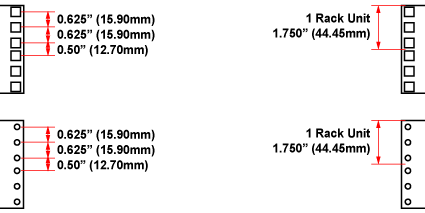
Back to Top
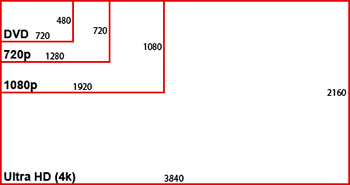 Also known as UHD, Ultra-HD is the 4K video resolution used for consumer displays. Compared with 1080p, Ultra-HD has double the lines of vertical resolution and double the number of pixels of horizontal resolution, featuring a 3840x2160 resolution, while maintaining the 16:9 aspect ratio of home-entertainment TVs.
Also known as UHD, Ultra-HD is the 4K video resolution used for consumer displays. Compared with 1080p, Ultra-HD has double the lines of vertical resolution and double the number of pixels of horizontal resolution, featuring a 3840x2160 resolution, while maintaining the 16:9 aspect ratio of home-entertainment TVs.
Unbalanced audio is what will be found in the typical home stereo. It is used to connect a DVD player through RCA jacks on a TV, hook some speakers to a computer sound card, or plug headphones into an iPod.
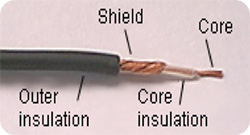 Unbalanced audio is more susceptible to noise, so cable length should be kept as short as possible, and it is important to keep them away from power cords and power supplies.
Unbalanced audio is more susceptible to noise, so cable length should be kept as short as possible, and it is important to keep them away from power cords and power supplies.
An unbalanced audio cable uses a single center conductor and the shield (ground) for the audio signal to travel on. Since the audio travels on the shield of the cable, any interference that the shield picks up will be inserted on the audio signal. This could come across in any number of audible ways, from hums to radio stations.
Common connectors used for unbalanced audio include RCA and 3.5 mm or ¼" TS (Tip, Sleeve) connectors, commonly found on computer sound cards.
See: balanced audio.
Back to Top
Universal Serial Bus (USB) is an industry standard that establishes specifications for cables, connectors and protocols for connection, communication and power supply between computers, peripheral devices and other computers.
Released in 1996, the USB standard is currently maintained by the USB Implementers Forum (USB-IF).
A major component in the legacy-free PC, USB was designed to allow peripherals to be connected using a single standardized interface socket, to improve plug-and-play capabilities by allowing devices to be connected and disconnected without rebooting the computer (hot swapping).
Other convenient features include powering low-consumption devices without the need for an external power supply and allowing some devices to be used without requiring individual device drivers to be installed.
There have been four generations of USB specifications: USB 1.x, USB 2.0, USB 3.x and USB 4.


USB 1.0 and 1.1 have a maximum bandwidth of 12 Mbps.
Up to 127 peripheral devices can be attached to the bus.
Back to Top Universial Serial Bus (USB) 2.0 is a complete overhaul of the Universal Serial Bus input/output bus protocol which allows much higher speeds than the older USB 1.1 standard did.
Universial Serial Bus (USB) 2.0 is a complete overhaul of the Universal Serial Bus input/output bus protocol which allows much higher speeds than the older USB 1.1 standard did.
The goal of the new serial bus is to broaden the range of external peripherals that can be used on a computer.
Hi-Speed USB 2.0 has a maximum bandwidth of 480 Mbps. Up to 127 peripheral devices can be attached to the bus, and USB 1.1 devices can plug into USB 2.0 ports.
Fast devices can use the full bandwidth, while low-speed ones can use a 1.5 Mbps sub-channel.
Back to Top
 USB 3.0 is the second major revision of the Universal Serial Bus (USB) standard for computer connectivity. First introduced in 2008, USB 3.0 adds a new transfer mode called "SuperSpeed," (distinguishable from USB 2.0 by either the blue color of the port or the initials SS) capable of transferring data at up to 5 Gbps - over 10 times faster than the 480 Gbps top speed of USB 2.0.
USB 3.0 is the second major revision of the Universal Serial Bus (USB) standard for computer connectivity. First introduced in 2008, USB 3.0 adds a new transfer mode called "SuperSpeed," (distinguishable from USB 2.0 by either the blue color of the port or the initials SS) capable of transferring data at up to 5 Gbps - over 10 times faster than the 480 Gbps top speed of USB 2.0.
The USB 3.0 specification is similar to USB 2.0 but with many improvements and an alternative implementation. The changes in this specification make improvements in the following areas:
- Transfer speed – Added a new transfer type called Super Speed or SS – 5 Gbps (electrically it is more similar to PCIe Gen2 and SATA than USB 2.0) - 10x the data transfer rate of Hi-Speed USB 2.0.
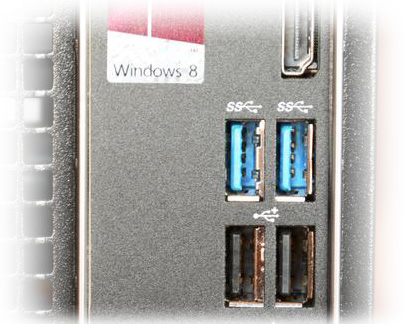 Increased bandwidth – Instead of one-way communication, USB 3.0 uses two unidirectional data paths: one to receive data and the other to transmit.
Increased bandwidth – Instead of one-way communication, USB 3.0 uses two unidirectional data paths: one to receive data and the other to transmit.- Increased power output (in comparison to USB 2.0) - 5V, 1.8A.
- SuperSpeed USB 3.0 is a Sync-N-Go technology that minimizes user wait-time.
- Power management – SuperSpeed USB 3.0 provides Optimized Power Efficiency. No device polling and lower active and idle power requirements.
- Improved bus utilization – A new feature is added (using packets NRDY and ERDY) to let a device asynchronously notify the host of its readiness (no need of polling).
USB 3.0 plugs and connectors are usually colored blue, with the female connector typically marked with the USB SS symbol. SuperSpeed USB 3.0 is backwards compatible with USB 2.0. Devices inter-operate with USB 2.0 platforms. Hosts support USB 2.0 legacy devices.

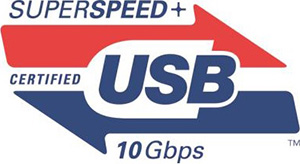
Released in July 2013, USB 3.1 - AKA USB SuperSpeed Plus, and SuperSpeed USB 10 Gbps - makes a number of improvements over the previous versions including:
• Data transfer rates: doubles the speed of USB 3.0 to 10Gbps, making it as fast as the original Thunderbolt standard.
• Enhanced power delivery: up to 20 volts, 5 amps, and 100 watts for power and charging, which supports charging a laptop.
• Audio/video: built-in support for DisplayPort video and four channel audio (speaker and microphone).
USB 3.1 is backward-compatible with USB 3.0 and USB 2.0, including existing USB 3.0 software stacks and device class protocols as well as with existing 5Gbps hubs and devices and USB 2.0 products. USB 3.1 best utilizes all its features when used with USB Type-C cables and connectors.
USB 3.1 is also referred to as USB 3.1 Gen 2 (generation 2), whereas USB 3.1 Gen 1 is essentially identical to USB 3.0 ,with speeds up to only 5Gbps.
Back to Top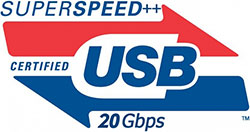 First announced in 2017, the USB 3.2 specification introduces changes to the way manufacturers communicate and advertise transfer speeds.
First announced in 2017, the USB 3.2 specification introduces changes to the way manufacturers communicate and advertise transfer speeds.
AKA USB SuperSpeed ++, and SuperSpeed USB 20 Gbps - the newest, fastest version of USB 3.2 offers a max speed of 20Gbps and is called USB 3.2 Gen 2x2. (The 2x2 means it's the second generation and has two 10Gbps lanes to achieve its maximum throughput of 20Gbps.)
The USB 3.2 specification enables 20Gbps data-transfer rates because it allows for up to two lanes of 10Gbps but only using Type-C cables, hence the '2x2' in USB 3.2 Gen 2x2.
The USB 3.2 specification also absorbs USB 3.0 and 3.1 specifications, with USB 3.2 now denoting three different speed tiers.

The USB 4 specification was released on August 29, 2019 by USB Implementers Forum.
USB 4 is based on the Thunderbolt 3 protocol specification. It supports 40 Gbit/s throughput, is compatible with Thunderbolt 3, and backwards compatible with USB 3.2 and USB 2.0.
The architecture defines a method to share a single high-speed link with multiple end device types dynamically that best serves the transfer of data by type and application.
Back to Top
A device that increases the number of USB ports on a computer, typically providing at least four Type A sockets for expansion. Like any other USB device, the hub plugs into a USB port on the computer and provides four or more USB ports for peripherals.
The peripherals themselves may also contain hubs. USB hubs are often used to extend ports to the top of the desk to make it more convenient to connect and remove external peripherals. For example, a monitor may have a built-in USB hub in order to provide a convenient desktop location for plugging in other devices.
Back to Top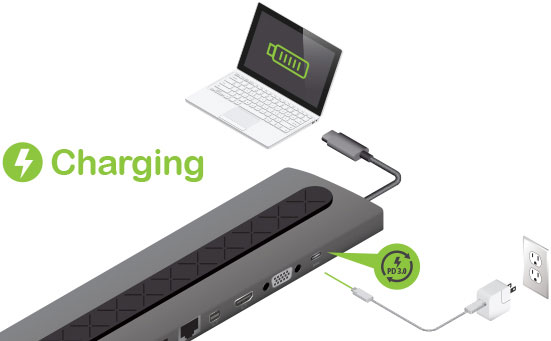 USB Power Delivery (or PD, for short) is a single charging standard for handling power, allowing a range of devices to charge quickly over a USB connection.
USB Power Delivery (or PD, for short) is a single charging standard for handling power, allowing a range of devices to charge quickly over a USB connection.
Normally, each device charged by USB has its own separate adapter, but not anymore. One universal USB PD is able to power a wide variety of different devices.
USB Power Delivery operates by facilitating a conversation between two devices to negotiate a power contract so they can determine how much power can be pulled from the charger.
Power Delivery starts at the 5V setting and is configurable up to 20V. Using a standard USB-C cable, USB Power Delivery has increased standard power levels to up to 100W. This means your device will be able to charge much faster than before.
Another point of interest regarding Power Delivery is that it allows for power to flow both ways, with no set direction based on circuit or connection. For example, in the past, if you plugged your phone into the computer, it would charge your phone. But with Power Delivery, the phone you plug in could be responsible for powering your hard drive.
Power Delivery also ensures devices are not overcharged, providing only the necessary amount of juice needed. While most smart phones aren't able to take advantage of the added power, many other devices and computers are able to.
As our phones and devices continue to use up more and more power, USB Power Delivery is likely to become more and more common. Even power banks now have USB PD to charge or operate devices that demand a lot of power (think MacBooks, Switches, GoPros, drones and more). With Power Delivery, a range of devices can share their charges with one another and power each other without hassle. Power Delivery is simply a much easier and streamlined way to go about charging all of your devices.
Back to Top
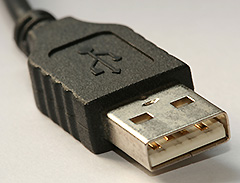
Also known as USB Standard-A, USB Type-A is the original design for the USB standard with a flat and rectangular shape.
On a typical USB cable, the Type A connector, aka the A-male connector, is the end that goes into a host, such as a computer. And on a host, the USB port (or receptacle) where the Type A-male goes into, is called an A-female port. Type-A ports are mostly in host devices, including desktop computers, laptops, game consoles, media players and so on. There are very few peripheral devices that use a Type-A port.
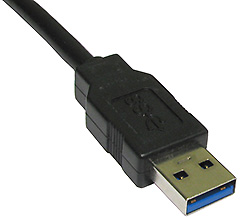
Different USB versions including USB 1.1, USB 2.0, USB 3.0 currently share the same USB Type-A design (although USB 3.0 implements a blue color-coding on both male and female connectors, instead of the previous white color) . This means a Type-A connector is always compatible with a Type-A port event if the device and host use different USB versions. For example, a USB 3.0 external hard drive also works with a USB 2.0 port, and vice versa.
Similarly, small devices such as a mouse, keyboard, or network adapter that have hard-wired USB cables always use Type-A connectors. That's true also for things without cables, such as a thumb drive.
Though USB 3.0's connectors and ports have more pins than those of USB 2.0 versions to deliver faster speed and higher power output, these pins are organized in a way that doesn't prevent them from physically working with the older version.
Note: There are smaller Type-A plugs and connectors, including Mini Type-A and Micro Type-A, but there are very few devices that use these designs.
Back to Top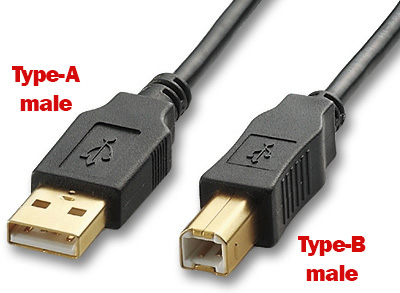
Typically, the Type-B connector is the other end of a standard USB cable that plugs into peripheral device (such as a printer, a phone, or an external hard drive). It's also known as Type B-male. On the peripheral device, the USB port is called Type B-female.
Since the peripheral devices vary a great deal in shape and size, the Type-B connector and its respective port also come in many different designs. Up to now there have been five popular designs for the USB Type-B's plugs and connectors. And since the Type-A end of a USB cable remains the same, the Type-B end is used to determine the name of the cable itself.
The original standard (Standard-B): This design was first made for USB 1.1 and is also used in USB 2.0. It's mostly for connecting large peripheral devices, such as printers or scanners to a computer.
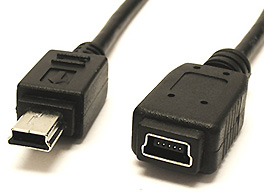
Mini-USB (or Mini-B USB): Significantly smaller, the Mini-USB Type-B ports are found in older portable devices, such as digital cameras and smartphones. This design is becoming obsolete.
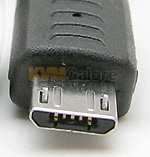
Micro-USB (or Micro-B USB): Slightly smaller than Mini-USB, the Micro-USB Type-B port is currently the most popular USB port design for latest smartphones and tablets.
Micro-USB 3.0 (or Micro-B USB 3.0): This is the widest design and mostly used for USB 3.0 portable drives. Most of the time, the Type-A end of the cable is blue.
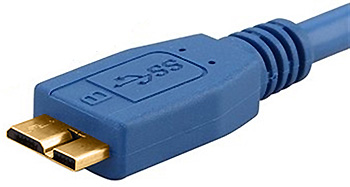
Standard-B USB 3.0: This design is very similar to the Standard-B, however, it's designed to handle USB 3.0 speed. Most of the time, both ends of the cable are blue.
Note: There's also another, less popular, USB 3.0 Powered-B plug and connector. This design has two additional pins to provide extra power to the peripheral device.

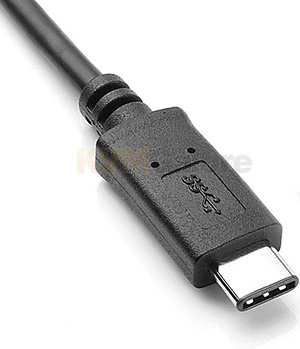 Developed at roughly the same time as the USB 3.1 specification, but distinct from it, USB Type-C defines a new small reversible-plug connector for USB devices.
Developed at roughly the same time as the USB 3.1 specification, but distinct from it, USB Type-C defines a new small reversible-plug connector for USB devices.
USB Type-C...
- Slim and sleek connector tailored to fit mobile device product designs, yet robust enough for laptops and tablets
- Features reversible plug orientation
- Features reversible cable direction
- Supports high power output
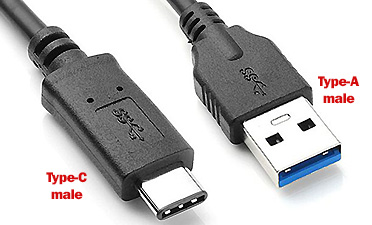
Physically, USB Type-C port and connector is about the same size as that of the Micro-B USB, measuring just 8.4mm by 2.6mm. This means it's small enough to work for even the smallest peripheral devices. With Type-C, a USB cable's both ends will be the same, allowing for reversible plug orientation. You also don't need to worry about plugging it in upside down.
USB Type-C plug connects to both hosts and devices, replacing various Type-B and Type-A connectors and cables with a standard meant to be future-proof, similarly to Apple Lightning and Thunderbolt.
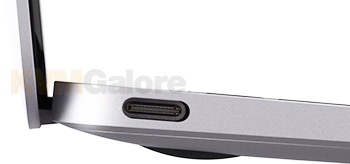 USB Type-C supports USB 3.1 with the top speed of 10Gbps and has much higher power output of up to 20V (100W) and 5A. Considering most 15-inch notebook computers require just around 60W of power, this means laptop computers can be charged the way tablets and smartphones are now, via their little USB port.
USB Type-C supports USB 3.1 with the top speed of 10Gbps and has much higher power output of up to 20V (100W) and 5A. Considering most 15-inch notebook computers require just around 60W of power, this means laptop computers can be charged the way tablets and smartphones are now, via their little USB port.
USB Type-C also allows for bi-directional power, so apart from charging the peripheral device, when applicable, a peripheral device could also charge a host device.
Type-A and Type-B adapters are required for older devices in order to plug into USB Type-C hosts.
Back to TopVideo Electronic Standards Association, a consortium of manufacturers formed to establish and maintain industry wide standards for video cards and monitors. VESA was instrumental in the introduction of the Super VGA and Extended VGA video graphics standards with a refresh rate of 70 Hz, minimizing flicker and helping to reduce user eyestrain and fatigue.
Back to Top
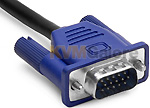 Video Graphics Array (VGA) is an analog computer display standard first marketed in 1987 by IBM. It has been technologically outdated in the PC market for some time.
Video Graphics Array (VGA) is an analog computer display standard first marketed in 1987 by IBM. It has been technologically outdated in the PC market for some time.
VGA was the most recent graphical standard that the majority of manufacturers conformed to, making it the lowest common denominator that all PC graphics hardware supports before a device-specific driver is loaded into the computer. For example, the Microsoft Windows splash screen appears while the machine is still operating in VGA mode, which is the reason that this screen always appears in reduced resolution and color depth.
VGA refers to a resolution of 640×480, regardless of the hardware that produces it. Most commonly, however, VGA is referred to the 15-pin D-subminiature connector which is still widely used to carry analog video signals of all resolutions.
A VGA connector is a three-row 15-pin connector. The 15-pin VGA connector is found on many video cards, computer monitors, and some high definition television sets.
VGA connector is also conventionally called RGB connector, D-sub 15, mini sub D15, mini D15, DB-15, HDB-15, HD-15 or HD15.
VGA connectors and cables carry analog component RGBHV (red, green, blue, horizontal sync, vertical sync) video signals, and VESA Display Data Channel (VESA DDC) data.
Back to Top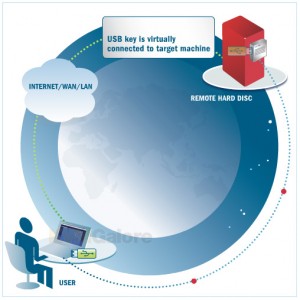 Virtual media - typically combined with a KVM-over-IP switch - is a feature that allows a remote user (using a computer in a remote location) to use files located on a local storage media (USB stick; CD-ROM; Flash memory; External drive, etc.) when working on a remote server. The virtual media feature allows the remote user to quickly and easily move and copy data between the storage media and the server, over the network (Internet; LAN; WAN), just as if the storage media were directly attached to that server's USB port.
Virtual media - typically combined with a KVM-over-IP switch - is a feature that allows a remote user (using a computer in a remote location) to use files located on a local storage media (USB stick; CD-ROM; Flash memory; External drive, etc.) when working on a remote server. The virtual media feature allows the remote user to quickly and easily move and copy data between the storage media and the server, over the network (Internet; LAN; WAN), just as if the storage media were directly attached to that server's USB port.
Using virtual media, a remote operator can install application and OS patches, download files and perform diagnostic testing on a remote server without physically entering the data center where the server is located.
Back to Top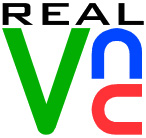 [Also known as Real VNC] In computing, Virtual Network Computing (VNC) is a graphical desktop sharing system that uses the Remote Frame Buffer protocol (RFB) to remotely control another computer. It transmits the keyboard and mouse events from one computer to another, relaying the graphical screen updates back in the other direction, over a network. Popular uses for this technology include remote technical support and accessing files on one's work computer from one's home computer, or vice versa.
[Also known as Real VNC] In computing, Virtual Network Computing (VNC) is a graphical desktop sharing system that uses the Remote Frame Buffer protocol (RFB) to remotely control another computer. It transmits the keyboard and mouse events from one computer to another, relaying the graphical screen updates back in the other direction, over a network. Popular uses for this technology include remote technical support and accessing files on one's work computer from one's home computer, or vice versa.
VNC is platform-independent – a VNC viewer on one operating system may connect to a VNC server on the same or any other operating system.
There are a number of variants of VNC which offer their own particular functionality; e.g., some optimized for Microsoft Windows, or offering file transfer (not part of VNC proper), etc. Many are compatible (without their added features) with VNC proper in the sense that a viewer of one flavor can connect with a server of another; others are based on VNC code but not compatible with standard VNC.
VNC and RFB are registered trademarks of RealVNC Ltd.
Back to TopWide Area Network. Multiple LAN's connected together via telephone lines or radio waves. The Internet is a WAN.
Back to Top Wireless Home Digital Interface (WHDI) is a consumer electronic specification for a wireless HDTV connectivity throughout the home. WHDI technology enables delivery of uncompressed high-definition digital video over a wireless radio channel throughout the home, connecting any video source (computers, mobile phones, Blu-ray players etc.) to any compatible display device with video rates of up to 1080p in the 5Ghz unlicensed band.
Wireless Home Digital Interface (WHDI) is a consumer electronic specification for a wireless HDTV connectivity throughout the home. WHDI technology enables delivery of uncompressed high-definition digital video over a wireless radio channel throughout the home, connecting any video source (computers, mobile phones, Blu-ray players etc.) to any compatible display device with video rates of up to 1080p in the 5Ghz unlicensed band.
WHDI surpasses competitive technologies by providing outstanding and consistent picture quality equivalent to wired HDMI™ cable, low latency, multi-room availability and low power consumption.
WHDI revolutionizes the home multimedia experience by wirelessly delivering interactive HD video from any device to any display, allowing consumers to wirelessly connect HDTVs to video sources with high convenience and flexibility.
WHDI Consortium was formed and is supported and driven by Amimon, Hitachi, Motorola, Samsung, Sharp, Sony and LG Electronics.
Back to Top A display with a wider aspect ratio, typically 16 units wide for every 9 units high (16:9).
A display with a wider aspect ratio, typically 16 units wide for every 9 units high (16:9).
Widescreen displays are popular because they more accurately represent the aspect ratio of a movie theater and present a better viewing experience.
Back to TopThe World Wide Web (abbreviated as WWW, commonly known as the Web) is a system of interlinked hypertext documents (Web sites) accessed via the Internet.
The Web is a subset of the Internet. The Web consists of pages that can be accessed using a Web browser. The Internet is the actual network of networks where all the information resides.
The Hyper-Text Transfer Protocol (HTTP) is the method used to transfer Web pages to your computer. With hypertext, a word or phrase can contain a link to another Web site. All Web pages are written in the hyper-text markup language (HTML), which works in conjunction with HTTP.
The World Wide Web is the most widely used part of the Internet. Its outstanding feature is hypertext, a method of instant cross-referencing. In most Web sites, certain words or phrases appear in text of a different color than the rest; often this text is also underlined. When you select one of these words or phrases, you will be transferred to the site or page that is relevant to this word or phrase. Sometimes there are buttons, images, or portions of images that are "clickable." If you move the pointer over a spot on a Web site and the pointer changes into a hand, this indicates that you can click and be transferred to another site.
Using the Web, you have access to millions of pages of information. Web browsing is done with a Web browser such as Internet Explorer, Firefox, Chrome or Safari. With a Web browser, one can view Web pages that may contain text, images, videos, and other multimedia and navigate between them via hyperlinks.
Back to Top
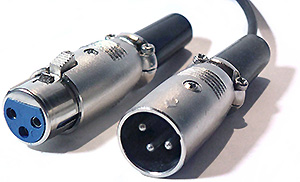 XLR connector is a style of electrical connector, primarily found on professional audio, video, and stage lighting equipment.
XLR connector is a style of electrical connector, primarily found on professional audio, video, and stage lighting equipment.
The connector is circular in design and has between 3 and 7 pins. It is most commonly associated with balanced audio interconnection, including AES3 digital audio, but is also used for lighting control, low-voltage power supplies, and other applications.
XLR connectors are available from a number of manufacturers and are covered by an international standard for dimensions, IEC 61076-2-103.
XLR connectors are superficially similar to the older and smaller DIN connector range, but are not physically compatible with them.
A smaller version, the mini XLR connector, is used on smaller equipment having physical size limitations.
Back to Top




